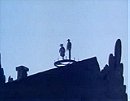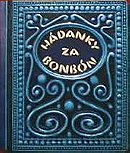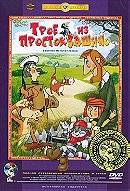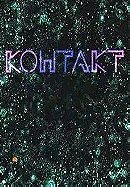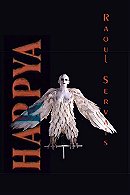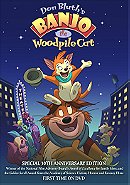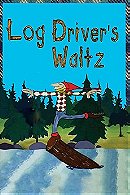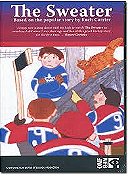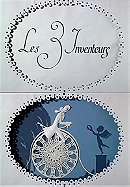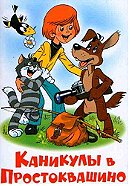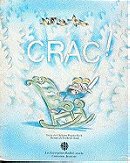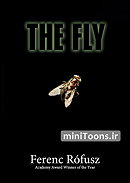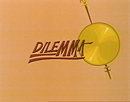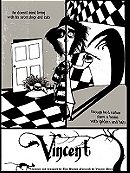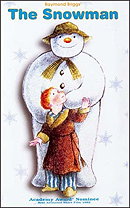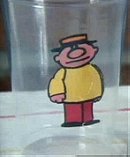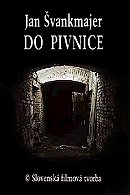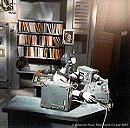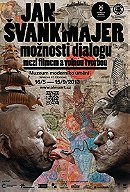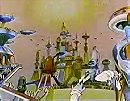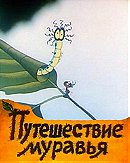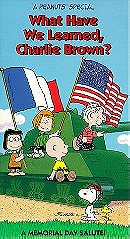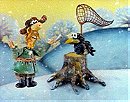1001 Animated Shorts You Must See - Part 11
Sort by:
Showing 50 items
Decade:
Rating:
List Type:
DIR: John Weldon, Eunice Macaulay
SUMMARY: A tangled farce involving an icy walkway, an adulterous wife and a dead postman.
WHY IT'S HERE: John Weldon and Eunice Macaulay's 'Special Delivery', is a wonderfully dark little farce involving a dead postman, an adulterous wife, a wrongful arrest and lots of wrongly jumped-to conclusions. 'Special Delivery's greatest strength is its script, written by the film's directors Eunice Macaulay and John Weldon but the simple animation style seems perfectly suited to this droll little tale. It a neatly representative film for the many wonderful cartoons that came from The National Film Board of Canada.
SUMMARY: A tangled farce involving an icy walkway, an adulterous wife and a dead postman.
WHY IT'S HERE: John Weldon and Eunice Macaulay's 'Special Delivery', is a wonderfully dark little farce involving a dead postman, an adulterous wife, a wrongful arrest and lots of wrongly jumped-to conclusions. 'Special Delivery's greatest strength is its script, written by the film's directors Eunice Macaulay and John Weldon but the simple animation style seems perfectly suited to this droll little tale. It a neatly representative film for the many wonderful cartoons that came from The National Film Board of Canada.
Oh My Darling (1978)
DIR: Borge Ring
SUMMARY: An examination of a young girl's changing relationship with her parents as she grows up and finds love.
WHY IT'S HERE: Danish animator Borge Ring was a prominent member of the animation team for several high-profile projects of the 60s and 70s, including the Asterix films, 'It's the Great Pumpkin, Charlie Brown' and 'The Smurfs and the Magic Flute'. But it wasn't until 1978 that he might his directorial debut with the Oscar nominated 'Oh My Darling'. This personal project was a cut above the work he was doing for other studios and established a distinctive, extraordinarily appealing style that would be used again in Ring's subsequent shorts 'Anna & Bella' and 'Run of the Mill'. 'Oh My Darling' follows the lives of a mum and dad and their little girl. The apple of her father's eye, the girl is also the victim of a mother who does not want her to grow up. But as she develops and meets a man, the parents cannot stand in her way anymore. But what role do they now play in her life? As with all of Ring's work, 'Oh My Darling' is both deeply moving and enjoyably comic. In a short runtime, Ring manages to draw us into a time frame of a few decades and the final image, of a father caught between his wife and daughter, is a fitting end to a film rich in symbolism.
SUMMARY: An examination of a young girl's changing relationship with her parents as she grows up and finds love.
WHY IT'S HERE: Danish animator Borge Ring was a prominent member of the animation team for several high-profile projects of the 60s and 70s, including the Asterix films, 'It's the Great Pumpkin, Charlie Brown' and 'The Smurfs and the Magic Flute'. But it wasn't until 1978 that he might his directorial debut with the Oscar nominated 'Oh My Darling'. This personal project was a cut above the work he was doing for other studios and established a distinctive, extraordinarily appealing style that would be used again in Ring's subsequent shorts 'Anna & Bella' and 'Run of the Mill'. 'Oh My Darling' follows the lives of a mum and dad and their little girl. The apple of her father's eye, the girl is also the victim of a mother who does not want her to grow up. But as she develops and meets a man, the parents cannot stand in her way anymore. But what role do they now play in her life? As with all of Ring's work, 'Oh My Darling' is both deeply moving and enjoyably comic. In a short runtime, Ring manages to draw us into a time frame of a few decades and the final image, of a father caught between his wife and daughter, is a fitting end to a film rich in symbolism.
Rip Van Winkle (1978)
DIR: Will Vinton
SUMMARY: Washington Irving's tale of Rip Van Winkle is brought to life in Claymation.
WHY IT'S HERE: Pioneering claymation director Will Vinton's 'Rip Van Winkle' is a fantastic short from the creator of 1980s icons The California Raisins. The oft-underrated Vinton marries his gorgeous, detailed, slightly creepy style perfectly with Washington Irving's folksy tale to create a sumptuous half hour of animation. The film peaks with an extended, surreal dream-sequence which is a feast for the eyes. If any of Vinton's shorts really showcased his potential for making the exquisite feature length 'The Adventures of Mark Twain' then this was it. Sadly, both these films are underrated, underseen gems.
SUMMARY: Washington Irving's tale of Rip Van Winkle is brought to life in Claymation.
WHY IT'S HERE: Pioneering claymation director Will Vinton's 'Rip Van Winkle' is a fantastic short from the creator of 1980s icons The California Raisins. The oft-underrated Vinton marries his gorgeous, detailed, slightly creepy style perfectly with Washington Irving's folksy tale to create a sumptuous half hour of animation. The film peaks with an extended, surreal dream-sequence which is a feast for the eyes. If any of Vinton's shorts really showcased his potential for making the exquisite feature length 'The Adventures of Mark Twain' then this was it. Sadly, both these films are underrated, underseen gems.
DIR: Caroline Leaf
SUMMARY: An adaptation of Kafka's 'The Metamorphosis', in which salesman Gregor Samsa awakes to find he has been transformed into a large insect-like creature.
WHY IT'S HERE: Franz Kafka's famous story 'The Metamorphosis' is the basis for Caroline Leaf's follow-up to 'The Street'. While that film had been painted on glass, for 'The Metamorphosis of Mr. Samsa' Leaf works even more painstakingly in sand. Kafka's novella was suggested to Leaf as a fitting subject for sand animation as its dark subject matter fitted with the literally dark look of moving sand and the simplicity of the images this necessitates. But if the silhouette-like images are simple, the animation and its eerily effective flow are anything but. It's easy to appreciate how much work has gone into this short but what most impresses me is that even while working with sand, Leaf manages to maintain her auteurist stamp on the project. Watched side by side with 'The Street', this is clearly the work of the same animator and yet the diversity of the two pieces is also apparent. It is an impressive contradiction applied to one of the most famous puzzles of 20th century literature.
SUMMARY: An adaptation of Kafka's 'The Metamorphosis', in which salesman Gregor Samsa awakes to find he has been transformed into a large insect-like creature.
WHY IT'S HERE: Franz Kafka's famous story 'The Metamorphosis' is the basis for Caroline Leaf's follow-up to 'The Street'. While that film had been painted on glass, for 'The Metamorphosis of Mr. Samsa' Leaf works even more painstakingly in sand. Kafka's novella was suggested to Leaf as a fitting subject for sand animation as its dark subject matter fitted with the literally dark look of moving sand and the simplicity of the images this necessitates. But if the silhouette-like images are simple, the animation and its eerily effective flow are anything but. It's easy to appreciate how much work has gone into this short but what most impresses me is that even while working with sand, Leaf manages to maintain her auteurist stamp on the project. Watched side by side with 'The Street', this is clearly the work of the same animator and yet the diversity of the two pieces is also apparent. It is an impressive contradiction applied to one of the most famous puzzles of 20th century literature.
Satiemania (1978)
DIR: Zdenko Gasparovic
SUMMARY: A series of images set to the music of Erik Satie.
WHY IT'S HERE: French composer and pianist Erik Satie is often referred to as the father of modern music whose work is a precursor to surrealism and the Theatre of the Absurd. These strong influences are more than apparent in Croatian animator Zdenko Gasparovic's 'Satiemania', a surrealist animation set to the music of Satie. Though Gasparovic would go on to be best known for his work on various animated TV shows, particularly Nickolodeon series like 'Rugrats' and 'As Told by Ginger', 'Satiemania' remains his masterpiece and a great inspiration on many great animators of the 1980s. Though the film has no plot per se, its images knit together into some kind of logical oneness. The film begins with comic images of various characters walking around to one of Satie's more upbeat compositions but as the music darkens, so does the imagery. In one particularly memorable moment, a grotesque woman eat a slice of cake bites off her entire hand with it, munching obliviously on her own flesh and bone. This kind of violent imagery abounds along with some sexual content but none of it seems at all exploitative or gratuitous. In one oddly beautiful scene, Gasparovic fixates on a woman's face as she orgasms, with butterflies emerging from her mouth at the crucial moment.
SUMMARY: A series of images set to the music of Erik Satie.
WHY IT'S HERE: French composer and pianist Erik Satie is often referred to as the father of modern music whose work is a precursor to surrealism and the Theatre of the Absurd. These strong influences are more than apparent in Croatian animator Zdenko Gasparovic's 'Satiemania', a surrealist animation set to the music of Satie. Though Gasparovic would go on to be best known for his work on various animated TV shows, particularly Nickolodeon series like 'Rugrats' and 'As Told by Ginger', 'Satiemania' remains his masterpiece and a great inspiration on many great animators of the 1980s. Though the film has no plot per se, its images knit together into some kind of logical oneness. The film begins with comic images of various characters walking around to one of Satie's more upbeat compositions but as the music darkens, so does the imagery. In one particularly memorable moment, a grotesque woman eat a slice of cake bites off her entire hand with it, munching obliviously on her own flesh and bone. This kind of violent imagery abounds along with some sexual content but none of it seems at all exploitative or gratuitous. In one oddly beautiful scene, Gasparovic fixates on a woman's face as she orgasms, with butterflies emerging from her mouth at the crucial moment.
Afterlife (1978)
DIR: Ishu Patel
SUMMARY: An attempt to explore the concept of dying and passage into the afterlife.
WHY IT'S HERE: Ishu Patel's experimental short 'Afterlife' begins with a hauntingly vivid image of a man's lonely death and then follows his departed spirit into the afterlife. Patel portrays the afterlife as a methodical working-out of past experiences, although the images are vague and symbolic. In contrast with his previous Oscar nominated short 'The Bead Game', which had an obvious message clear to any viewer, 'Afterlife' is a much more cryptic piece of work that is never less than beautiful, if at times frustratingly elusive.
SUMMARY: An attempt to explore the concept of dying and passage into the afterlife.
WHY IT'S HERE: Ishu Patel's experimental short 'Afterlife' begins with a hauntingly vivid image of a man's lonely death and then follows his departed spirit into the afterlife. Patel portrays the afterlife as a methodical working-out of past experiences, although the images are vague and symbolic. In contrast with his previous Oscar nominated short 'The Bead Game', which had an obvious message clear to any viewer, 'Afterlife' is a much more cryptic piece of work that is never less than beautiful, if at times frustratingly elusive.
Riddles for a Candy (1978)
DIR: Jiri Barta
SUMMARY: A strange creature shapes shifts as he pursues a small candy through a book of riddles.
WHY IT'S HERE: The brilliant Czech animator Jiri Barta's debut stop-motion short 'Riddles for a Candy' is quite different from the darker works for which he would become known. Instead, Barta here offers a comic, brightly coloured pursuit of a candy through a book of riddles. The large, shape-shifting creature at the centre of the story is wonderfully animated as he attempts to solve a series of bamboozling riddles in order to obtain the coveted candy. It's a lovely if somewhat baffling debut short but the visuals more than make up for any shortcomings in the story and 'Riddles for a Candy' is never less than amusing.
SUMMARY: A strange creature shapes shifts as he pursues a small candy through a book of riddles.
WHY IT'S HERE: The brilliant Czech animator Jiri Barta's debut stop-motion short 'Riddles for a Candy' is quite different from the darker works for which he would become known. Instead, Barta here offers a comic, brightly coloured pursuit of a candy through a book of riddles. The large, shape-shifting creature at the centre of the story is wonderfully animated as he attempts to solve a series of bamboozling riddles in order to obtain the coveted candy. It's a lovely if somewhat baffling debut short but the visuals more than make up for any shortcomings in the story and 'Riddles for a Candy' is never less than amusing.
DIR: Vladamir Popov
SUMMARY: A young boy, known as Uncle Fyodor due to his serious demeanour, leaves home when he is not allowed to have a cat and sets up his own home with a cat, dog and bird in the village of Prostokvashino.
WHY IT'S HERE: Vladamir Popov's 'Three from Prostokvashino' is a delightful adaptation of the popular Russian children's books by Eduard Uspensky, who also provided the source material for Roman Kachanov's classic 'Cheburashka' shorts. Sharing the same warm but witty tone, 'Three from Prostokvashino' is animated with charming simplicity and its story is so easy going and enjoyable that it is impossible not to get drawn in. Realism is not a factor here. Quite apart from talking animals, the protagonists of 'Three from Prostokvashino' are perhaps the luckiest protagonists in animation history! They go looking for a home and find an abandoned house with a sign that invites anyone who wants to live there to do so free of charge. They find they need money so they go treasure hunting and immediately find treasure! These convenient plot points are dropped in with a knowing wink and it's a breath of fresh air to enjoy some time in a world where everything goes right. The characters in 'Three from Prostokvashino' are all wonderfully realised too. The vain cat Matroskin, the friendly dog Sharik, the mean and nosy mailman Pechkin and Uncle Fyodor's parents all have great moments. Perhaps my favourite is the argument between the parents in which the mother tells the father he must choose between her and the cat. The laid back father casually shrugs "OK, I choose you. I've known you for a long time already but I see this cat for the first time!"
SUMMARY: A young boy, known as Uncle Fyodor due to his serious demeanour, leaves home when he is not allowed to have a cat and sets up his own home with a cat, dog and bird in the village of Prostokvashino.
WHY IT'S HERE: Vladamir Popov's 'Three from Prostokvashino' is a delightful adaptation of the popular Russian children's books by Eduard Uspensky, who also provided the source material for Roman Kachanov's classic 'Cheburashka' shorts. Sharing the same warm but witty tone, 'Three from Prostokvashino' is animated with charming simplicity and its story is so easy going and enjoyable that it is impossible not to get drawn in. Realism is not a factor here. Quite apart from talking animals, the protagonists of 'Three from Prostokvashino' are perhaps the luckiest protagonists in animation history! They go looking for a home and find an abandoned house with a sign that invites anyone who wants to live there to do so free of charge. They find they need money so they go treasure hunting and immediately find treasure! These convenient plot points are dropped in with a knowing wink and it's a breath of fresh air to enjoy some time in a world where everything goes right. The characters in 'Three from Prostokvashino' are all wonderfully realised too. The vain cat Matroskin, the friendly dog Sharik, the mean and nosy mailman Pechkin and Uncle Fyodor's parents all have great moments. Perhaps my favourite is the argument between the parents in which the mother tells the father he must choose between her and the cat. The laid back father casually shrugs "OK, I choose you. I've known you for a long time already but I see this cat for the first time!"
The Small One (1978)
DIR: Don Bluth
SUMMARY: A young boy must part with his best friend, a small donkey, when the family can no longer afford to keep him.
WHY IT'S HERE: Disney's 'The Small One' is a heavy-handedly sentimental short which is nevertheless notable for several reasons. For one, 'The Small One' is one of the few overtly religious films Disney released. More significantly however, 'The Small One' also marked the directorial debut of Don Bluth, the Disney animator who would eventually briefly become the studio's chief commercial rival. Bluth's only solo directorial film for Disney, 'The Small One' betrays his reverence for the high artistic standards of Disney's earlier work. The quality of this 25 minute short is significantly superior to much of Disney's feature-length product of this era and Bluth's desire to steer the studio back towards its former glories clashed both with those who wanted to explore money-saving techniques or less conservative, modern approaches. Soon after 'The Small One', Bluth would leave Disney and take with him a group of animators with whom he set up Don Bluth Entertainment, making popular films such as 'An American Tail' and 'The Land Before Time'. Bluth's obvious potential is clear in 'The Small One' but so are his weaknesses, such as an overburdening of sentimentality and some truly awful songs. Big things were expected of 'The Small One' but instead it slipped into relative obscurity. It remains as sweet and visually impressive featurette which signposts the emergence of one of the most popular animation names of the 80s.
SUMMARY: A young boy must part with his best friend, a small donkey, when the family can no longer afford to keep him.
WHY IT'S HERE: Disney's 'The Small One' is a heavy-handedly sentimental short which is nevertheless notable for several reasons. For one, 'The Small One' is one of the few overtly religious films Disney released. More significantly however, 'The Small One' also marked the directorial debut of Don Bluth, the Disney animator who would eventually briefly become the studio's chief commercial rival. Bluth's only solo directorial film for Disney, 'The Small One' betrays his reverence for the high artistic standards of Disney's earlier work. The quality of this 25 minute short is significantly superior to much of Disney's feature-length product of this era and Bluth's desire to steer the studio back towards its former glories clashed both with those who wanted to explore money-saving techniques or less conservative, modern approaches. Soon after 'The Small One', Bluth would leave Disney and take with him a group of animators with whom he set up Don Bluth Entertainment, making popular films such as 'An American Tail' and 'The Land Before Time'. Bluth's obvious potential is clear in 'The Small One' but so are his weaknesses, such as an overburdening of sentimentality and some truly awful songs. Big things were expected of 'The Small One' but instead it slipped into relative obscurity. It remains as sweet and visually impressive featurette which signposts the emergence of one of the most popular animation names of the 80s.
DIR: Sheila Graber
SUMMARY: An animated version of the artist Modrian presents a history of his work set to the Boogie Woogie music he loved.
WHY IT'S HERE: British animator Sheila Graber is perhaps best known for working on the classic animated children's TV series 'Paddington' but she also made her own short animations and in 1978 she released her masterpiece 'Mondrian'. Screened at the Tate Gallery, Mondrian's own house in the Netherlands and one the BBC's 'Blue Peter', 'Mondrian' is a terrific short in which a small animated version of the titular artist presents various pieces of his art to the sound of the Boogie Woogie music he loved. Graber's animations is captivatingly lively and the combination of the artwork and music is brilliantly effective. Though this short has now fallen into relative obscurity, I've loved it since I first saw it many years ago on Channel 4, back in the glory days when animation was a regular feature of that channel's output.
SUMMARY: An animated version of the artist Modrian presents a history of his work set to the Boogie Woogie music he loved.
WHY IT'S HERE: British animator Sheila Graber is perhaps best known for working on the classic animated children's TV series 'Paddington' but she also made her own short animations and in 1978 she released her masterpiece 'Mondrian'. Screened at the Tate Gallery, Mondrian's own house in the Netherlands and one the BBC's 'Blue Peter', 'Mondrian' is a terrific short in which a small animated version of the titular artist presents various pieces of his art to the sound of the Boogie Woogie music he loved. Graber's animations is captivatingly lively and the combination of the artwork and music is brilliantly effective. Though this short has now fallen into relative obscurity, I've loved it since I first saw it many years ago on Channel 4, back in the glory days when animation was a regular feature of that channel's output.
DIR: Vladimir Tarasov
SUMMARY: An artist's ideal walk in the country is interrupted by the arrival of an alien being attempting to make contact.
WHY IT'S HERE: Russian director Vladimir Tarasov considered animation to be 'the Esperanto of all mankind' and he makes that point emphatically with the wonderful 'Contact', a colourful, funny and sympathetic short in which a painter is terrorised by an alien who is only trying to make contact through finding common ground. As the painter runs for his life, convinced that the alien has the same fate in mind for him as human beings do towards the nature we so mercilessly exploit, the alien attempts to show his friendly intentions by shapeshifting into various familiar forms. Finally though it is music, that other 'Esperanto of all mankind', that brings the two together. Tarasov's colourful artwork is reminiscent of 'Yellow Submarine', which chimes fittingly with 'Contact's hippy ideals.
SUMMARY: An artist's ideal walk in the country is interrupted by the arrival of an alien being attempting to make contact.
WHY IT'S HERE: Russian director Vladimir Tarasov considered animation to be 'the Esperanto of all mankind' and he makes that point emphatically with the wonderful 'Contact', a colourful, funny and sympathetic short in which a painter is terrorised by an alien who is only trying to make contact through finding common ground. As the painter runs for his life, convinced that the alien has the same fate in mind for him as human beings do towards the nature we so mercilessly exploit, the alien attempts to show his friendly intentions by shapeshifting into various familiar forms. Finally though it is music, that other 'Esperanto of all mankind', that brings the two together. Tarasov's colourful artwork is reminiscent of 'Yellow Submarine', which chimes fittingly with 'Contact's hippy ideals.
Robbery, …-Style (1978)
DIR: Yefim Gamburg
SUMMARY: A robbery is shown as portrayed using the crime genre clichés of four different countries.
WHY IT'S HERE: Russian director Yefim Gamburg was known for his parodic style and in 'Robbery, ...-Style' he created an effective parody and satire of various countries and their cinematic heritage. 'Robbery, ...-Style' shows a robbery plot in the style of four different countries. The American portion of the film is violent and fast paced, the French subtle and Noirish, while the Italian take on the plot is in full colour and nods its head to various Mafia films. Finally, the Russian portion of the film depicts an inefficient Soviet economy, in that the robbers are unable to rob the savings office because it is constantly closed. Gamburg's film is amusing but quite pointed and was only shown in Russia with the final portion removed (this is the only section which does not have a title making its country of origin clear, but the intention was obvious to censors). 'Robbery, ...-Style's characters are all modelled on popular actors from their respective countries, such as Marlon Brandon, Alain Delon and Sophia Loren. Some knowledge of crime films and their various international equivalents is necessary to really enjoy 'Robbery, ...-Style' but its episodic, fast paced antics should please film buffs like myself. Also worthy of note in this respect is the opening shot in which MGM's Leo the Lion is replaced by Russian icon Cheburashka.
SUMMARY: A robbery is shown as portrayed using the crime genre clichés of four different countries.
WHY IT'S HERE: Russian director Yefim Gamburg was known for his parodic style and in 'Robbery, ...-Style' he created an effective parody and satire of various countries and their cinematic heritage. 'Robbery, ...-Style' shows a robbery plot in the style of four different countries. The American portion of the film is violent and fast paced, the French subtle and Noirish, while the Italian take on the plot is in full colour and nods its head to various Mafia films. Finally, the Russian portion of the film depicts an inefficient Soviet economy, in that the robbers are unable to rob the savings office because it is constantly closed. Gamburg's film is amusing but quite pointed and was only shown in Russia with the final portion removed (this is the only section which does not have a title making its country of origin clear, but the intention was obvious to censors). 'Robbery, ...-Style's characters are all modelled on popular actors from their respective countries, such as Marlon Brandon, Alain Delon and Sophia Loren. Some knowledge of crime films and their various international equivalents is necessary to really enjoy 'Robbery, ...-Style' but its episodic, fast paced antics should please film buffs like myself. Also worthy of note in this respect is the opening shot in which MGM's Leo the Lion is replaced by Russian icon Cheburashka.
DIR: Raoul Servais
SUMMARY: A man comes to the rescue of a woman who is being strangled, only to discover that she is in fact a ravenous Harpy.
WHY IT'S HERE: Raoul Servais's 'Harypa' is a terrifying, disturbing but blackly comic short featuring live-action actors animated against a black velvet background. The effect is mesmerizingly eerie, offset by 'Harpya's touch of vaudeville grotesquery which somehow makes it all the more troubling. Rather than drown his film in eerie music cues telling us how to feel, 'Harpya' instead relies on small sound effects which leave the disconcerted viewer wondering if their reaction (alternating between horror and laughter) is the appropriate one to the events on screen. It's all part of the unique experience and 'Harpya's simple, suspenseful tale etches itself on the memory.
SUMMARY: A man comes to the rescue of a woman who is being strangled, only to discover that she is in fact a ravenous Harpy.
WHY IT'S HERE: Raoul Servais's 'Harypa' is a terrifying, disturbing but blackly comic short featuring live-action actors animated against a black velvet background. The effect is mesmerizingly eerie, offset by 'Harpya's touch of vaudeville grotesquery which somehow makes it all the more troubling. Rather than drown his film in eerie music cues telling us how to feel, 'Harpya' instead relies on small sound effects which leave the disconcerted viewer wondering if their reaction (alternating between horror and laughter) is the appropriate one to the events on screen. It's all part of the unique experience and 'Harpya's simple, suspenseful tale etches itself on the memory.
Stalk of the Celery Monster (1979)
DIR: Tim Burton
SUMMARY: A mad doctor is experimenting on a patient... but all is not what it seems.
WHY IT'S HERE: 'Stalk of the Celery Monster' is a very early animation by Tim Burton. Created as a student project, this brief short was enough to win him an animator's apprenticeship with Disney. Only portions of the film survive today but from the less than two minutes that survive it is clear that a major talent is involved. The pencil-sketched characters all look fantastic, with their cartoonish appeal offsetting the darker themes and the final goofy twist ending the short nicely. Although only available in fragments, 'Stalk of the Celery Monster' is filled with potential and elements of the black humour that would become one of Burton's trademarks. For fans of his later work, it's a fascinating watch.
SUMMARY: A mad doctor is experimenting on a patient... but all is not what it seems.
WHY IT'S HERE: 'Stalk of the Celery Monster' is a very early animation by Tim Burton. Created as a student project, this brief short was enough to win him an animator's apprenticeship with Disney. Only portions of the film survive today but from the less than two minutes that survive it is clear that a major talent is involved. The pencil-sketched characters all look fantastic, with their cartoonish appeal offsetting the darker themes and the final goofy twist ending the short nicely. Although only available in fragments, 'Stalk of the Celery Monster' is filled with potential and elements of the black humour that would become one of Burton's trademarks. For fans of his later work, it's a fascinating watch.
DIR: Bob Godfrey, Zlatko Grgic
SUMMARY: A lonely man begins a relationship with an inflatable doll that seems to have a mind of its own.
WHY IT'S HERE: Bob Godfrey and Zlatko Grgic's bizarre 'Dream Doll' is a parody of French film 'The Red Balloon', only with the titular balloon replaced by a lifesize sex doll. 'Dream Doll' is a cut-above the other leery sex films of Bob Godfrey (although there's still an evident breast fixation on display here), which were generally one-note affairs in which stiff-upper-lipped British men talked frankly about sexual fantasies or positions, without ever breaking from their incongruously inhibited manner of speaking (see 'Karma Sutra Rides Again'... actually, don't!). Where 'Dream Doll' wins over these flimsier films is in its unlikely achievement of real pathos and emotional involvement in the story of a lonely man who attempts to start a relationship (both physical and romantic) with a sex doll that seems to have a mind of its own. The ending, including one moment of genuine sadness, is unforgettable. There's a really creepy but somehow sweet feel to 'Dream Doll' and, though it has undoubtedly dated, it's still a very impressive oddity.
SUMMARY: A lonely man begins a relationship with an inflatable doll that seems to have a mind of its own.
WHY IT'S HERE: Bob Godfrey and Zlatko Grgic's bizarre 'Dream Doll' is a parody of French film 'The Red Balloon', only with the titular balloon replaced by a lifesize sex doll. 'Dream Doll' is a cut-above the other leery sex films of Bob Godfrey (although there's still an evident breast fixation on display here), which were generally one-note affairs in which stiff-upper-lipped British men talked frankly about sexual fantasies or positions, without ever breaking from their incongruously inhibited manner of speaking (see 'Karma Sutra Rides Again'... actually, don't!). Where 'Dream Doll' wins over these flimsier films is in its unlikely achievement of real pathos and emotional involvement in the story of a lonely man who attempts to start a relationship (both physical and romantic) with a sex doll that seems to have a mind of its own. The ending, including one moment of genuine sadness, is unforgettable. There's a really creepy but somehow sweet feel to 'Dream Doll' and, though it has undoubtedly dated, it's still a very impressive oddity.
DIR: Don Bluth
SUMMARY: To avoid being spanked for jumping off the roof to see if he would land on his feet., Banjo the cat stows away on a truck to Salt Lake City. Finding city life tougher than expected, he enlists the help of streetwise cat Crazy Legs to help him get home.
WHY IT'S HERE: While he was still working at Disney but was disillusioned with the declining quality of their output, Don Bluth secretly began working on 'Banjo the Woodpile Cat' in his garage. Assembling a team of like-minded Disney animators who were willing to sacrifice their evenings and weekends for the project, Bluth created the first official release by Don Bluth Productions. For a film made on a shoestring budget, 'Banjo the Woodpile Cat' is an impressive half-hour featurette with some good artwork and animation. However, it sadly epitomises many of the weaknesses that prevented Bluth's work from ever reaching the heights of classic Disney. The plotting is weak, haphazard and anti-climactic, the characters are underdeveloped and the songs are instantly forgettable or else gratingly irritating. These are all forgivable elements given the circumstances under which 'Banjo the Woodpile Cat' was made but they unfortunately carried over into Bluth's intermittently impressive feature films of the 80s. Nevertheless, Bluth managed to carve out his own popular niche and had a handful of hits before his career inevitably faltered. 'Banjo the Woodpile Cat' is a worthwhile little short and testament to the talents of a man who put a bit too much stock in classic animation and not enough in good storytelling.
SUMMARY: To avoid being spanked for jumping off the roof to see if he would land on his feet., Banjo the cat stows away on a truck to Salt Lake City. Finding city life tougher than expected, he enlists the help of streetwise cat Crazy Legs to help him get home.
WHY IT'S HERE: While he was still working at Disney but was disillusioned with the declining quality of their output, Don Bluth secretly began working on 'Banjo the Woodpile Cat' in his garage. Assembling a team of like-minded Disney animators who were willing to sacrifice their evenings and weekends for the project, Bluth created the first official release by Don Bluth Productions. For a film made on a shoestring budget, 'Banjo the Woodpile Cat' is an impressive half-hour featurette with some good artwork and animation. However, it sadly epitomises many of the weaknesses that prevented Bluth's work from ever reaching the heights of classic Disney. The plotting is weak, haphazard and anti-climactic, the characters are underdeveloped and the songs are instantly forgettable or else gratingly irritating. These are all forgivable elements given the circumstances under which 'Banjo the Woodpile Cat' was made but they unfortunately carried over into Bluth's intermittently impressive feature films of the 80s. Nevertheless, Bluth managed to carve out his own popular niche and had a handful of hits before his career inevitably faltered. 'Banjo the Woodpile Cat' is a worthwhile little short and testament to the talents of a man who put a bit too much stock in classic animation and not enough in good storytelling.
Tale of Tales (1979) (1979)
DIR: Yuriy Norshteyn
SUMMARY: A little grey wolf from a child's lullaby becomes the spectator of, and occasional participant in, a series of symbolic, interlinked memories of an unspecified mind.
WHY IT'S HERE: With his previous short 'Hedgehog in the Fog', Yuriy Norshteyn had already established himself as one of the most important animation directors of all time. But his subsequent short, 'Tale of Tales', managed to make his previous masterwork seem almost like a trivial children's film by comparison. An audaciously ambitious, exquisitely immersive and indefatigably unique film, 'Tale of Tales' manages to tap into an emotional vein that no other film, animated or otherwise, has ever quite reached. Frequent comparisons have been made with Andrei Tarkovsky's live-action 'Mirror' but I'd say 'Tale of Tales' is more affecting still than that.
Combining half-remembered fragments of childhood with indecipherable surreal images and elements of Russian history, 'Tale of Tales' maintains its all-encompassing melancholic mood throughout its half hour runtime. Norshteyn works mainly in muddy browns, greys and black, with only the occasional patch of colour or intrusion from a bright white light which seems to have a transportative property for the little wolf. But amongst this dark palette we see images of a nostalgic quality as well as moments of deep sadness. One of the film's most celebrated images is that of a group of dancing couples. As the record they're dancing to begins to skip, one of the men disappears with each jump, and the happy figures become hunched soldiers on their way to war. Moments later, notices of death flutter back to the hands of the women like purposeful birds, removing the men from their lives forever.
Not every image is so easy to interpret, but full understanding was never the point of this film and to impose a rigid interpretation is to rob it of its power to tap into the viewer's own feelings and memories. Watching 'Tale of Tales' is akin to being asleep. Where else would you encounter such vividly obtuse images as a large, downhearted bull perpetually engaged in a skipping game. Cynics who would shrug all this off as pretentious nonsense ought to see the film if only to appreciate its disarming visual beauty and the subtle diversity of Norshteyn's vision. Notes of comedy are even introduced in the mannerisms of the wolf as he burns his paw on a hot potato or in the casual demeanour of a young boy sharing his apple with a group of crows. Ultimately, for all its melancholia, 'Tale of Tales' leaves the viewer feeling invigorated, challenged and fulfilled. It may take a few viewings to completely weave its magic but the experience of watching this short is like nothing else and it is best enjoyed alone, with no distractions to take you out of the experience. Not for nothing has 'Tale of Tales' been voted the best animated short ever made by several different sources. It is a truly singular experience.
SUMMARY: A little grey wolf from a child's lullaby becomes the spectator of, and occasional participant in, a series of symbolic, interlinked memories of an unspecified mind.
WHY IT'S HERE: With his previous short 'Hedgehog in the Fog', Yuriy Norshteyn had already established himself as one of the most important animation directors of all time. But his subsequent short, 'Tale of Tales', managed to make his previous masterwork seem almost like a trivial children's film by comparison. An audaciously ambitious, exquisitely immersive and indefatigably unique film, 'Tale of Tales' manages to tap into an emotional vein that no other film, animated or otherwise, has ever quite reached. Frequent comparisons have been made with Andrei Tarkovsky's live-action 'Mirror' but I'd say 'Tale of Tales' is more affecting still than that.
Combining half-remembered fragments of childhood with indecipherable surreal images and elements of Russian history, 'Tale of Tales' maintains its all-encompassing melancholic mood throughout its half hour runtime. Norshteyn works mainly in muddy browns, greys and black, with only the occasional patch of colour or intrusion from a bright white light which seems to have a transportative property for the little wolf. But amongst this dark palette we see images of a nostalgic quality as well as moments of deep sadness. One of the film's most celebrated images is that of a group of dancing couples. As the record they're dancing to begins to skip, one of the men disappears with each jump, and the happy figures become hunched soldiers on their way to war. Moments later, notices of death flutter back to the hands of the women like purposeful birds, removing the men from their lives forever.
Not every image is so easy to interpret, but full understanding was never the point of this film and to impose a rigid interpretation is to rob it of its power to tap into the viewer's own feelings and memories. Watching 'Tale of Tales' is akin to being asleep. Where else would you encounter such vividly obtuse images as a large, downhearted bull perpetually engaged in a skipping game. Cynics who would shrug all this off as pretentious nonsense ought to see the film if only to appreciate its disarming visual beauty and the subtle diversity of Norshteyn's vision. Notes of comedy are even introduced in the mannerisms of the wolf as he burns his paw on a hot potato or in the casual demeanour of a young boy sharing his apple with a group of crows. Ultimately, for all its melancholia, 'Tale of Tales' leaves the viewer feeling invigorated, challenged and fulfilled. It may take a few viewings to completely weave its magic but the experience of watching this short is like nothing else and it is best enjoyed alone, with no distractions to take you out of the experience. Not for nothing has 'Tale of Tales' been voted the best animated short ever made by several different sources. It is a truly singular experience.
DIR: John Weldon
SUMMARY: An animated music video to the song 'Log Driver's Waltz' by Wade Hemsworth.
WHY IT'S HERE: Made as part of the National Film Board of Canada's series of 'Canadian Vignettes', John Weldon's 'Log Driver's Waltz' became one of the most frequently requested films of the series. Set to an arrangement of Wade Hemsworth's 'Log Driver's Waltz' by Kate and Anna McGarrigle and the Mountain City Four, the short depicts the job of log driving, a practice in the lumber industry which involved transporting felled timber by having workers walk or run on the logs as they floated down rivers. Weldon's humorous animation is bursting with energy and the resulting three minute short is one of the most charming pieces of 70s animation. Uplifting, brief and beautiful, 'Log Driver's Waltz' is highly recommended to lift the spirits of anyone having a bad day!
SUMMARY: An animated music video to the song 'Log Driver's Waltz' by Wade Hemsworth.
WHY IT'S HERE: Made as part of the National Film Board of Canada's series of 'Canadian Vignettes', John Weldon's 'Log Driver's Waltz' became one of the most frequently requested films of the series. Set to an arrangement of Wade Hemsworth's 'Log Driver's Waltz' by Kate and Anna McGarrigle and the Mountain City Four, the short depicts the job of log driving, a practice in the lumber industry which involved transporting felled timber by having workers walk or run on the logs as they floated down rivers. Weldon's humorous animation is bursting with energy and the resulting three minute short is one of the most charming pieces of 70s animation. Uplifting, brief and beautiful, 'Log Driver's Waltz' is highly recommended to lift the spirits of anyone having a bad day!
Getting Started (1979)
DIR: Richard Condie
SUMMARY: A pianist procrastinates in order to avoid rehearsing a Debussy composition.
WHY IT'S HERE: Canadian animator Richard Condie's 'Getting Started' is a little masterpiece focusing on the minutiae of the condition of being unable to settle. Following ten minutes in the life of a pianist who just cannot seem to get started with his rehearsals, Condie's trademark perversity seems to be in full force in his choice of subject matter. After all, how is the condition of being inanimate ever going to make for a good animated short? At first it seems to be a budgetary concern, as Condie holds for a minute on a still shot of an open door while we listen to the pianist's activities offscreen. However, when he re-enters the room the full genius of Condie's short becomes apparent. The chronic procrastinator is not inanimate at all. Rather he is the victim of a multitude of pointless, tiny little movements all designed to distract himself from the task in hand. The character's frustrated monologue is accompanied by a hilarious stream of aimless endeavours which gradually but emphatically drive him into a piano-gnawing frenzy. 'Getting Started' is a great introduction to Condie's work. His recognisable style is in evidence but the surrealism and grotesquery that characterised some of his brilliant later shorts are reined in here in favour of a witty social realism. There can be few viewers who will not recognise the agony of trying and failing to start out with something important which Condie reproduces with such accuracy and wit.
SUMMARY: A pianist procrastinates in order to avoid rehearsing a Debussy composition.
WHY IT'S HERE: Canadian animator Richard Condie's 'Getting Started' is a little masterpiece focusing on the minutiae of the condition of being unable to settle. Following ten minutes in the life of a pianist who just cannot seem to get started with his rehearsals, Condie's trademark perversity seems to be in full force in his choice of subject matter. After all, how is the condition of being inanimate ever going to make for a good animated short? At first it seems to be a budgetary concern, as Condie holds for a minute on a still shot of an open door while we listen to the pianist's activities offscreen. However, when he re-enters the room the full genius of Condie's short becomes apparent. The chronic procrastinator is not inanimate at all. Rather he is the victim of a multitude of pointless, tiny little movements all designed to distract himself from the task in hand. The character's frustrated monologue is accompanied by a hilarious stream of aimless endeavours which gradually but emphatically drive him into a piano-gnawing frenzy. 'Getting Started' is a great introduction to Condie's work. His recognisable style is in evidence but the surrealism and grotesquery that characterised some of his brilliant later shorts are reined in here in favour of a witty social realism. There can be few viewers who will not recognise the agony of trying and failing to start out with something important which Condie reproduces with such accuracy and wit.
DIR: Garri Bardin
SUMMARY: A princess falls in love with a chimney sweep who promises to build her a flying ship. To avoid marrying the suitor her father has in mind for her, the princess decrees that the man she will marry must build her a flying ship.
WHY IT'S HERE: Russian animator Garri Bardin would later become more famous for stop motion animation but this early cel animated fairy tale is a cult gem. Bursting with colour and lively music, the style of 'The Flying Ship' immediately calls to mind classic Soyuzmultfilm films such as 'Ivan and the Magic Pony' but 'The Flying Ship' has a subtly subversive side to it. Starting out with the hoary old plot point of a princess who does not want to marry the suitor her father has chosen for her, 'The Flying Ship' opens with what looks like a traditional woe-is-me ballad from a princess trapped by circumstance. However, when it reaches its chorus the princess starts flinging crockery from the window and wailing at the top of her voice. This is no delicate flower, and Bardin's design deviates from the slender, buxom princesses we're used to for a significantly more voluptuous design. Although the story follows fairly standard fairy tale lines from hereon in, the approach is inventive and consistently appealing and the finale, as the lovers fly away in their ship, adds a little unexpected moment in which they sing of how this fairy tale has a happy ending but real life is sadly not like that.
SUMMARY: A princess falls in love with a chimney sweep who promises to build her a flying ship. To avoid marrying the suitor her father has in mind for her, the princess decrees that the man she will marry must build her a flying ship.
WHY IT'S HERE: Russian animator Garri Bardin would later become more famous for stop motion animation but this early cel animated fairy tale is a cult gem. Bursting with colour and lively music, the style of 'The Flying Ship' immediately calls to mind classic Soyuzmultfilm films such as 'Ivan and the Magic Pony' but 'The Flying Ship' has a subtly subversive side to it. Starting out with the hoary old plot point of a princess who does not want to marry the suitor her father has chosen for her, 'The Flying Ship' opens with what looks like a traditional woe-is-me ballad from a princess trapped by circumstance. However, when it reaches its chorus the princess starts flinging crockery from the window and wailing at the top of her voice. This is no delicate flower, and Bardin's design deviates from the slender, buxom princesses we're used to for a significantly more voluptuous design. Although the story follows fairly standard fairy tale lines from hereon in, the approach is inventive and consistently appealing and the finale, as the lovers fly away in their ship, adds a little unexpected moment in which they sing of how this fairy tale has a happy ending but real life is sadly not like that.
Mr. Pascal (1979)
DIR: Alison De Vere
SUMMARY: A lonely, widowed shoemaker takes pity on an effigy of Christ.
WHY IT'S HERE: Alison De Vere's 'Mr. Pascal' is a fascinating film with religious subject matter but made by a director who did not have conventional religious beliefs herself. Rather, 'Mr. Pascal' stems from De Vere's lifelong dislike of the image of the crucified Christ. Having been exposed to this symbol throughout her life, De Vere made this humanistic but delightfully ambiguous and unpreachy short as a way to examine the power of sacred images compared with the meaning we should derive from them. In 'Mr. Pascal', the lonely title character finds some meaning in life when he liberates a statue of Christ from its place on a crucifix. Tending to his wounds and making him comfortable, Mr. Pascal succeeds in bringing Christ back to life, whereupon he becomes a source of happiness and community spirit once more, as opposed to the cold, neglected icon he had previously been. Set to the music of some street musicians who De Vere met on the underground and who appear in the film in animated form, 'Mr. Pascal' is a wonderful, thought provoking short for religious and non-religious audiences alike. The questions it asks may offend the rigidly traditionalist believers but this is no criticism, since these are the very people who should be encouraged to ask more questions.
SUMMARY: A lonely, widowed shoemaker takes pity on an effigy of Christ.
WHY IT'S HERE: Alison De Vere's 'Mr. Pascal' is a fascinating film with religious subject matter but made by a director who did not have conventional religious beliefs herself. Rather, 'Mr. Pascal' stems from De Vere's lifelong dislike of the image of the crucified Christ. Having been exposed to this symbol throughout her life, De Vere made this humanistic but delightfully ambiguous and unpreachy short as a way to examine the power of sacred images compared with the meaning we should derive from them. In 'Mr. Pascal', the lonely title character finds some meaning in life when he liberates a statue of Christ from its place on a crucifix. Tending to his wounds and making him comfortable, Mr. Pascal succeeds in bringing Christ back to life, whereupon he becomes a source of happiness and community spirit once more, as opposed to the cold, neglected icon he had previously been. Set to the music of some street musicians who De Vere met on the underground and who appear in the film in animated form, 'Mr. Pascal' is a wonderful, thought provoking short for religious and non-religious audiences alike. The questions it asks may offend the rigidly traditionalist believers but this is no criticism, since these are the very people who should be encouraged to ask more questions.
Autobahn (1979)
DIR: John Halas
SUMMARY: An animated music video for Kraftwerk's 'Autobahn'.
WHY IT'S HERE: 'Autobahn' is an abstract visual experiment set to the title track by Kraftwerk, a hit single in its edited form. The version used here lasts eleven minutes (although this is still an edited take, running half the length of the official album version) incorporating the famous, catchy portion of the song and several minutes of the more experimental noise collage that follows. The visual accompaniment is a cold, dreamlike drift through an otherworldly void, accompanied by a strange green alien creature. Depending on who you are, 'Autobahn' may bore you silly, confuse the hell out of you, transport you to another world, impress you greatly or a combination of all these elements. It’s a remarkable short from an era where music videos were still in their infancy and this bold stab at capturing Kraftwerk on a visual level adds another dimension to this electronic landmark.
SUMMARY: An animated music video for Kraftwerk's 'Autobahn'.
WHY IT'S HERE: 'Autobahn' is an abstract visual experiment set to the title track by Kraftwerk, a hit single in its edited form. The version used here lasts eleven minutes (although this is still an edited take, running half the length of the official album version) incorporating the famous, catchy portion of the song and several minutes of the more experimental noise collage that follows. The visual accompaniment is a cold, dreamlike drift through an otherworldly void, accompanied by a strange green alien creature. Depending on who you are, 'Autobahn' may bore you silly, confuse the hell out of you, transport you to another world, impress you greatly or a combination of all these elements. It’s a remarkable short from an era where music videos were still in their infancy and this bold stab at capturing Kraftwerk on a visual level adds another dimension to this electronic landmark.
The Sweater (1980)
DIR: Sheldon Cohen
SUMMARY: A young boy living in Quebec is horrified when he receives a hockey sweater for the wrong team in the post and his mother forces him to wear it.
WHY IT'S HERE: Based on Roch Carrier's short story 'The Hockey Sweater', an iconic and hugely popular piece of Canadian literature, 'The Sweater' is one of the most delightful, purely enjoyable animated anecdotes to come out of the National Film Board of Canada. Beautifully narrated by Carrier himself, Sheldon Cohen's sweetly appealing artwork imbues this story of a mortifying childhood episode with a warm sense of nostalgia for the country's obsession with hockey, the excitement of waiting for something in the post and the crushing disappointment when expectations are dashed. There is something in this short for everyone to relate to, although it holds a special significance for Canadians as an allegory for the tensions between francophone and Anglophone residents. This historical context lends 'The Sweater' even more thematic weight, although it is not necessary to know anything of this background in order to enjoy what is, on the face of it, a universally relevant story.
SUMMARY: A young boy living in Quebec is horrified when he receives a hockey sweater for the wrong team in the post and his mother forces him to wear it.
WHY IT'S HERE: Based on Roch Carrier's short story 'The Hockey Sweater', an iconic and hugely popular piece of Canadian literature, 'The Sweater' is one of the most delightful, purely enjoyable animated anecdotes to come out of the National Film Board of Canada. Beautifully narrated by Carrier himself, Sheldon Cohen's sweetly appealing artwork imbues this story of a mortifying childhood episode with a warm sense of nostalgia for the country's obsession with hockey, the excitement of waiting for something in the post and the crushing disappointment when expectations are dashed. There is something in this short for everyone to relate to, although it holds a special significance for Canadians as an allegory for the tensions between francophone and Anglophone residents. This historical context lends 'The Sweater' even more thematic weight, although it is not necessary to know anything of this background in order to enjoy what is, on the face of it, a universally relevant story.
The Three Inventors (1980)
DIR: Michel Ocelot
SUMMARY: A family of three inventors create a series of machines but encounter hostility from those who do not understand them and fear them as a consequence.
WHY IT'S HERE: French animator Michel Ocelot's 'The Three Inventors' is a wonderful short which clearly shows the potential he would go on to fulfil as one of the great directors of feature length animation. 'The Three Inventors' is animated using cut-out white paper, giving the effect of a world wrought in white lace. This technique foreshadows Ocelot's later work with silhouette animation on films such as 'Tales of the Night', in homage to the great Lotte Reiniger. Ocelot's animation is remarkably expressive given the simplicity of the figures, and the story is genuinely engaging and at times disturbing. The tragic denouement is softened by a little P.S. that Ocelot has appended, which simultaneously demonstrates that technological progress cannot be held back forever despite the fears of the conservatively minded.
SUMMARY: A family of three inventors create a series of machines but encounter hostility from those who do not understand them and fear them as a consequence.
WHY IT'S HERE: French animator Michel Ocelot's 'The Three Inventors' is a wonderful short which clearly shows the potential he would go on to fulfil as one of the great directors of feature length animation. 'The Three Inventors' is animated using cut-out white paper, giving the effect of a world wrought in white lace. This technique foreshadows Ocelot's later work with silhouette animation on films such as 'Tales of the Night', in homage to the great Lotte Reiniger. Ocelot's animation is remarkably expressive given the simplicity of the figures, and the story is genuinely engaging and at times disturbing. The tragic denouement is softened by a little P.S. that Ocelot has appended, which simultaneously demonstrates that technological progress cannot be held back forever despite the fears of the conservatively minded.
DIR: Vladamir Popov
SUMMARY: While his parents go on holiday to a resort, Uncle Fyodor prefers to spend his vacation in Prostokvashino with his old friends Matroskin and Sharik.
WHY IT'S HERE: Vladimir Popov's sequel to 'Three from Prostokvashino' is notable for continuing with the same breezy, enjoyable air as the first instalment. Although there is not much to speak of in the way of plot, 'Vacation in Prostokvashino' benefits from this narrative liberation, unfolding instead as a series of comic happenings. All of the characters from the original film return, with Pechkin the mailman causing more mean-spirited trouble in possibly the only episode that could be said to offer any narrative conflict. The beauty of the Prostokvashino shorts is how wonderfully enjoyable they are for no discernible reason. I'd spend my vacation in Prostokvashino anytime!
SUMMARY: While his parents go on holiday to a resort, Uncle Fyodor prefers to spend his vacation in Prostokvashino with his old friends Matroskin and Sharik.
WHY IT'S HERE: Vladimir Popov's sequel to 'Three from Prostokvashino' is notable for continuing with the same breezy, enjoyable air as the first instalment. Although there is not much to speak of in the way of plot, 'Vacation in Prostokvashino' benefits from this narrative liberation, unfolding instead as a series of comic happenings. All of the characters from the original film return, with Pechkin the mailman causing more mean-spirited trouble in possibly the only episode that could be said to offer any narrative conflict. The beauty of the Prostokvashino shorts is how wonderfully enjoyable they are for no discernible reason. I'd spend my vacation in Prostokvashino anytime!
DIR: Efrem Pruzhanskiy
SUMMARY: An adaptation of Lewis Carroll's 'Alice in Wonderland'.
WHY IT'S HERE: Whenever there is a new adaptation of 'Alice in Wonderland', people generally take the opportunity to bash the 1951 Disney version. So I found while researching this little-seen but highly-praised Russian adaptation of the story. Director Efrem Pruzhanskiy, who went on to direct a version of 'Through the Looking Glass' in the same style, has here created something extremely interesting visually. Unlike Disney's bright and colourful adaptation, Pruzhanskiy's rendering of the material is appropriately dark and eerie, giving Wonderland the nightmarishness of an absurd dream that could turn nasty at any moment. For all its pale, dull colours and captivatingly grotesque designs, however, Pruzhanskiy's version loses a lot of points in other areas. Tasked with squeezing the adaptation into three 10 minute segments, writer Yevgeni Zagdansky covers an impressive amount of ground but too often gets bogged down in Carroll's playful dialogue, which is witty on the page but slows things down to a crawl animation-wise. Also problematic is the weak voice cast, who all trot out their lines with zero enthusiasm, making it hard to get any kind of handle on what Pruzhanskiy is trying to bring out of the characters. The Queen of Hearts is completely non-threatening, her frequent calls for decapitation coming across as idle whims that are instantly forgotten. It's also worth noting that, in terms of dark subject matter, Disney's version also trumps Pruzhanskiy's. For instance, no-one here is actually beheaded whereas in the Disney version we see characters dragged off with this fate in store, never to be seen again. Disney version also has the merciless polishing off of a group of cute oysters by a hungry walrus. Finally, Pruzhanskiy's version is burdened with a theme-tune so sickly sweet and grating that any sense of foreboding that the great artwork may have suggested is completely lost. I can't be too harsh on 'Alice in Wonderland' as it is an interesting version that I'd recommend any fans of the story to see but for a genuinely nightmarish animated equivalent, go directly to Jan Svankmajer's 'Alice'.
SUMMARY: An adaptation of Lewis Carroll's 'Alice in Wonderland'.
WHY IT'S HERE: Whenever there is a new adaptation of 'Alice in Wonderland', people generally take the opportunity to bash the 1951 Disney version. So I found while researching this little-seen but highly-praised Russian adaptation of the story. Director Efrem Pruzhanskiy, who went on to direct a version of 'Through the Looking Glass' in the same style, has here created something extremely interesting visually. Unlike Disney's bright and colourful adaptation, Pruzhanskiy's rendering of the material is appropriately dark and eerie, giving Wonderland the nightmarishness of an absurd dream that could turn nasty at any moment. For all its pale, dull colours and captivatingly grotesque designs, however, Pruzhanskiy's version loses a lot of points in other areas. Tasked with squeezing the adaptation into three 10 minute segments, writer Yevgeni Zagdansky covers an impressive amount of ground but too often gets bogged down in Carroll's playful dialogue, which is witty on the page but slows things down to a crawl animation-wise. Also problematic is the weak voice cast, who all trot out their lines with zero enthusiasm, making it hard to get any kind of handle on what Pruzhanskiy is trying to bring out of the characters. The Queen of Hearts is completely non-threatening, her frequent calls for decapitation coming across as idle whims that are instantly forgotten. It's also worth noting that, in terms of dark subject matter, Disney's version also trumps Pruzhanskiy's. For instance, no-one here is actually beheaded whereas in the Disney version we see characters dragged off with this fate in store, never to be seen again. Disney version also has the merciless polishing off of a group of cute oysters by a hungry walrus. Finally, Pruzhanskiy's version is burdened with a theme-tune so sickly sweet and grating that any sense of foreboding that the great artwork may have suggested is completely lost. I can't be too harsh on 'Alice in Wonderland' as it is an interesting version that I'd recommend any fans of the story to see but for a genuinely nightmarish animated equivalent, go directly to Jan Svankmajer's 'Alice'.
DIR: Aleksandr Tatarskiy
SUMMARY: A musical retelling of the fable of the Fox and the Crow by a narrator who can't remember all the details.
WHY IT'S HERE: Russian animator Aleksandr Tatarskiy's 'Plasticine Crow' is a wonderfully energetic take on an old fable in which the details and moral of the story get lost among the indecisive narrator's attempts to recall the details. Using the technique of clay painting, in which everything is made from clay and we see the lumps of clay shaping into various characters and scenes (occasionally even being aided by an animator's hand coming into shot), 'Plasticine Crow' is fast paced, funny and somewhat baffling to people who are unfamiliar with the original fable. Even those who aren't may be left scratching their heads! It is so visually entertaining, charming and good-humoured however, that few could be disappointed by this lovely little curio.
SUMMARY: A musical retelling of the fable of the Fox and the Crow by a narrator who can't remember all the details.
WHY IT'S HERE: Russian animator Aleksandr Tatarskiy's 'Plasticine Crow' is a wonderfully energetic take on an old fable in which the details and moral of the story get lost among the indecisive narrator's attempts to recall the details. Using the technique of clay painting, in which everything is made from clay and we see the lumps of clay shaping into various characters and scenes (occasionally even being aided by an animator's hand coming into shot), 'Plasticine Crow' is fast paced, funny and somewhat baffling to people who are unfamiliar with the original fable. Even those who aren't may be left scratching their heads! It is so visually entertaining, charming and good-humoured however, that few could be disappointed by this lovely little curio.
DIR: Frederick Back
SUMMARY: The industrialisation of Montreal is seen through the eyes of a rocking chair.
WHY IT'S HERE: Frederick Back's 'Crac' is simply mesmerizing, one of the greatest shorts to win the Oscar in the history of the award. A visually sumptuous, musically captivating and narratively endearing look at the industrialisation of Montreal via the history of a rocking chair, 'Crac' is one of the most beautiful 15 minutes of animation you're ever likely to come across. By this stage of his career Back had become an artist of incredible talent and 'Crac', while not the most famous of his films, is the best. Deservedly scooping the Oscar for 1981, 'Crac' is so upbeat, colourful and infectious that it is impossible to resist. I would go so far as to call it one of the greatest animated shorts of all time.
SUMMARY: The industrialisation of Montreal is seen through the eyes of a rocking chair.
WHY IT'S HERE: Frederick Back's 'Crac' is simply mesmerizing, one of the greatest shorts to win the Oscar in the history of the award. A visually sumptuous, musically captivating and narratively endearing look at the industrialisation of Montreal via the history of a rocking chair, 'Crac' is one of the most beautiful 15 minutes of animation you're ever likely to come across. By this stage of his career Back had become an artist of incredible talent and 'Crac', while not the most famous of his films, is the best. Deservedly scooping the Oscar for 1981, 'Crac' is so upbeat, colourful and infectious that it is impossible to resist. I would go so far as to call it one of the greatest animated shorts of all time.
The Fly (1981) (1982)
DIR: Ferenc Rofusz
SUMMARY: A day in the life of a fly, from the fly's own perspective.
WHY IT'S HERE: Hungarian animator Ferenc Rofusz walked away with 1980 Oscar for Best Animated Short for his fascinating 3 minute look at the world from a fly's perspective. Despite technological advances which have made images like those seen here easier to produce, 'The Fly' still looks remarkable today, even more so for having been hand-drawn. The experience of watching 'The Fly' feels uncannily like being a fly yourself, resulting in a remarkable and slightly nauseating experience. While there is obviously not much to speak of in the way of plot, 'The Fly' is an artistic landmark in 80s animation quite different from any of the other Oscar winners of that decade.
SUMMARY: A day in the life of a fly, from the fly's own perspective.
WHY IT'S HERE: Hungarian animator Ferenc Rofusz walked away with 1980 Oscar for Best Animated Short for his fascinating 3 minute look at the world from a fly's perspective. Despite technological advances which have made images like those seen here easier to produce, 'The Fly' still looks remarkable today, even more so for having been hand-drawn. The experience of watching 'The Fly' feels uncannily like being a fly yourself, resulting in a remarkable and slightly nauseating experience. While there is obviously not much to speak of in the way of plot, 'The Fly' is an artistic landmark in 80s animation quite different from any of the other Oscar winners of that decade.
DIR: Michael Mills
SUMMARY: An extremely condensed depiction of world history through some of the planet's major events.
WHY IT'S HERE: A decade before 'History of the World in Three Minutes Flat', Canadian director Michael Mills attempted to squeeze all of evolution into a ten minute timeframe and got Oscar nominated in the process. The Academy obviously like concise history lessons because 'History of the World in Three Minutes Flat' got Mills nominated for his second and final Oscar. This ambitious, irreverent and very funny short begins with a couple of Biblical references before storming its way through a barrage of world events depicted in a series of witty, blink-and-you'll-miss-'em images. The short is very funny but there's a serious underlying message about just how many of these pivotal events focus around war, death and destruction. Mill's has no time for chin-stroking though. With just three minutes to work with, this film is all about the laughs and is all the better for it.
SUMMARY: An extremely condensed depiction of world history through some of the planet's major events.
WHY IT'S HERE: A decade before 'History of the World in Three Minutes Flat', Canadian director Michael Mills attempted to squeeze all of evolution into a ten minute timeframe and got Oscar nominated in the process. The Academy obviously like concise history lessons because 'History of the World in Three Minutes Flat' got Mills nominated for his second and final Oscar. This ambitious, irreverent and very funny short begins with a couple of Biblical references before storming its way through a barrage of world events depicted in a series of witty, blink-and-you'll-miss-'em images. The short is very funny but there's a serious underlying message about just how many of these pivotal events focus around war, death and destruction. Mill's has no time for chin-stroking though. With just three minutes to work with, this film is all about the laughs and is all the better for it.
Dilemma (1981)
DIR: John Halas
SUMMARY: A look at mankind's misuse of technology for destructive purposes.
WHY IT'S HERE: An early example of an entirely digital animation, Dilemma is another philosophical short examining how technology has been used for destructive and murderous purposes rather than for progressing mankind’s development as a peaceful race. At first Dilemma’s point seems elusive but as it becomes clearer Dilemma becomes more fascinating and gut-wrenching. There are some genuinely haunting moments, especially with the emergence of firearms, and the short leaves the viewer rooted to their seat and feeling cold and nervous. Dilemma may be remembered most for having been one of the shorts that played before the original cinema run of Return of the Jedi. It has planted itself firmly in the minds of many Star Wars fans since then but until now Dilemma has not been an easy film to track down. Its appearance here should delight anyone curious enough to have unearthed it once more.
SUMMARY: A look at mankind's misuse of technology for destructive purposes.
WHY IT'S HERE: An early example of an entirely digital animation, Dilemma is another philosophical short examining how technology has been used for destructive and murderous purposes rather than for progressing mankind’s development as a peaceful race. At first Dilemma’s point seems elusive but as it becomes clearer Dilemma becomes more fascinating and gut-wrenching. There are some genuinely haunting moments, especially with the emergence of firearms, and the short leaves the viewer rooted to their seat and feeling cold and nervous. Dilemma may be remembered most for having been one of the shorts that played before the original cinema run of Return of the Jedi. It has planted itself firmly in the minds of many Star Wars fans since then but until now Dilemma has not been an easy film to track down. Its appearance here should delight anyone curious enough to have unearthed it once more.
Here Comes Garfield (1982)
DIR: Phil Roman
SUMMARY: In Garfield's first TV appearance, Garfield and Odie end up in the local pound.
WHY IT'S HERE: The Garfield TV specials based on Jim Davis's brilliant comic strip quickly became popular staples of children's TV, eventually spawning a spin-off series 'Garfield and Friends'. Directed by Phil Roman, a veteran of Peanuts TV specials who would go on to direct the majority of the Garfield cartoons, 'Here Comes Garfield' was one of only two 'Garfield' specials to be produced by Mendelson-Melendez productions, the same company that made the Peanuts shorts, before duties were passed on to Film Roman Studios. Although it is far from the best of the Garfield specials, 'Here Comes Garfield' establishes many of the important elements that made the series so enduring, including the great music of Lou Rawls and Desirée Goyette and the voice talents of Lorenzo Music as Garfield. Reading the comic strips, it was hard to imagine a voice for Garfield but Lorenzo Music's laid-back drawl suits the character perfectly. Since Garfield's dialogue was always portrayed as thoughts rather than spoken words, there was no need to animate a moving mouth for the character, which must have been a relief but which also works very well, differentiating Garfield and his animal friends from the barrage of anthropomorphic creatures dominating children's TV. 'Here Comes Garfield' establishes the series tone well, with a gentle cynicism offset by a dash of sentimentality. The story does not flinch from the realities of pets being put down if not claimed from the pound, introducing some genuine peril into the story too. All in all, 'Here Comes Garfield' was a fine start to a popular TV franchise.
SUMMARY: In Garfield's first TV appearance, Garfield and Odie end up in the local pound.
WHY IT'S HERE: The Garfield TV specials based on Jim Davis's brilliant comic strip quickly became popular staples of children's TV, eventually spawning a spin-off series 'Garfield and Friends'. Directed by Phil Roman, a veteran of Peanuts TV specials who would go on to direct the majority of the Garfield cartoons, 'Here Comes Garfield' was one of only two 'Garfield' specials to be produced by Mendelson-Melendez productions, the same company that made the Peanuts shorts, before duties were passed on to Film Roman Studios. Although it is far from the best of the Garfield specials, 'Here Comes Garfield' establishes many of the important elements that made the series so enduring, including the great music of Lou Rawls and Desirée Goyette and the voice talents of Lorenzo Music as Garfield. Reading the comic strips, it was hard to imagine a voice for Garfield but Lorenzo Music's laid-back drawl suits the character perfectly. Since Garfield's dialogue was always portrayed as thoughts rather than spoken words, there was no need to animate a moving mouth for the character, which must have been a relief but which also works very well, differentiating Garfield and his animal friends from the barrage of anthropomorphic creatures dominating children's TV. 'Here Comes Garfield' establishes the series tone well, with a gentle cynicism offset by a dash of sentimentality. The story does not flinch from the realities of pets being put down if not claimed from the pound, introducing some genuine peril into the story too. All in all, 'Here Comes Garfield' was a fine start to a popular TV franchise.
Vincent (1982)
DIR: Tim Burton
SUMMARY: A young boy who idolises Vincent Price and Edgar Allen Poe gets lost in a fantasy world inspired by their ghoulish legacies.
WHY IT'S HERE: Tim Burton's 'Vincent' is a hugely stop-motion short which has received greater exposure due to the director's ascent to the status of household name. While working at Disney as a conceptual artist, Burton was given $60,000 by Head of Creative Development Tom Wilhite to finance a short film based on a poem he had written. The result was 'Vincent' a mini-masterpiece that took just 2 months to produce. The film is narrated brilliantly by Burton's childhood hero Vincent Price himself, who said of the experience that it was "the most gratifying thing that ever happened. It was immortality - better than a star on Hollywood Boulevard." This early association lead to a long-term friendship that lead to Price's role in 'Edward Scissorhands', his final film role before his death in 1993. 'Vincent' strikes a perfectly ghoulish tone somewhere between the macabre and the hilarious, with Vincent's fantasies of villainy and melodramatic maladies seeming to overtake him completely by the film's end. The simple but expressive models are a wonderful forerunner for Burton's designs for 'The Nightmare Before Christmas' and 'Corpse Bride' and 'Vincent' is an ideal opening short to play before either.
SUMMARY: A young boy who idolises Vincent Price and Edgar Allen Poe gets lost in a fantasy world inspired by their ghoulish legacies.
WHY IT'S HERE: Tim Burton's 'Vincent' is a hugely stop-motion short which has received greater exposure due to the director's ascent to the status of household name. While working at Disney as a conceptual artist, Burton was given $60,000 by Head of Creative Development Tom Wilhite to finance a short film based on a poem he had written. The result was 'Vincent' a mini-masterpiece that took just 2 months to produce. The film is narrated brilliantly by Burton's childhood hero Vincent Price himself, who said of the experience that it was "the most gratifying thing that ever happened. It was immortality - better than a star on Hollywood Boulevard." This early association lead to a long-term friendship that lead to Price's role in 'Edward Scissorhands', his final film role before his death in 1993. 'Vincent' strikes a perfectly ghoulish tone somewhere between the macabre and the hilarious, with Vincent's fantasies of villainy and melodramatic maladies seeming to overtake him completely by the film's end. The simple but expressive models are a wonderful forerunner for Burton's designs for 'The Nightmare Before Christmas' and 'Corpse Bride' and 'Vincent' is an ideal opening short to play before either.
DIR: Dianne Jackson
SUMMARY: A young boy builds a snowman which comes to life and takes him on a Christmas adventure.
WHY IT'S HERE: British director Dianne Jackson's 'The Snowman' is a breathtakingly beautiful adaptation of Raymond Briggs' picture book of the same name. A perennial favourite on Christmas TV in the UK, the annual airings of 'The Snowman' have not dimmed its appeal, instead enhancing its timeless quality with a warm seasonal glow. Although Briggs' source material makes no mention of Christmas, the subject matter was an obvious choice for a Christmas film and Jackson introduces new plot points involving a trip to see Father Christmas and a party with various other snowpeople. With its beautiful snowy visuals and the ever-popular Aled Jones song 'Walking in the Air' on the soundtrack, 'The Snowman' is as much a part of British Christmastime as mince pies and crackers, although its uncompromisingly sad ending introduces a touch of melancholia that has haunted many a childhood memory.
SUMMARY: A young boy builds a snowman which comes to life and takes him on a Christmas adventure.
WHY IT'S HERE: British director Dianne Jackson's 'The Snowman' is a breathtakingly beautiful adaptation of Raymond Briggs' picture book of the same name. A perennial favourite on Christmas TV in the UK, the annual airings of 'The Snowman' have not dimmed its appeal, instead enhancing its timeless quality with a warm seasonal glow. Although Briggs' source material makes no mention of Christmas, the subject matter was an obvious choice for a Christmas film and Jackson introduces new plot points involving a trip to see Father Christmas and a party with various other snowpeople. With its beautiful snowy visuals and the ever-popular Aled Jones song 'Walking in the Air' on the soundtrack, 'The Snowman' is as much a part of British Christmastime as mince pies and crackers, although its uncompromisingly sad ending introduces a touch of melancholia that has haunted many a childhood memory.
DIR: Michel Ocelot
SUMMARY: A hunchback's attempts to approach a beloved princess at the top of a large platform are thwarted by his own clumsiness and the violence of the courtiers who despise him. But their maltreatment unleashes a secret which even the hunchback was unaware of.
WHY IT'S HERE: Whether Michel Ocelot's 'The Legend of the Poor Hunchback' actually belongs on an animation list is debatable, since it tells its story more through a series of images than through moving pictures. It is this that makes the short so utterly unique and beguiling though. Ocelot works again with cut-outs but this time you really can't tell. Using white paper and felt tips, then greying the images with charcoal and pastel, the film looks like a 15th century wood carving. Told with no dialogue but set to the brilliant music of Christian Maire, 'The Legend of the Poor Hunchback' does eventually segue into some basic but monumentally effective animation as the plot's secret is revealed and the hunchback is differentiated from the stiff, ugly people that surround and spit on him. When speaking of the film, Ocelot decries the fact that it won a Cesar award when his more intricate 'The Three Inventors' did not, but I would concur that this simpler, devastatingly effective work is the better film of the two. Sorry Michel!
SUMMARY: A hunchback's attempts to approach a beloved princess at the top of a large platform are thwarted by his own clumsiness and the violence of the courtiers who despise him. But their maltreatment unleashes a secret which even the hunchback was unaware of.
WHY IT'S HERE: Whether Michel Ocelot's 'The Legend of the Poor Hunchback' actually belongs on an animation list is debatable, since it tells its story more through a series of images than through moving pictures. It is this that makes the short so utterly unique and beguiling though. Ocelot works again with cut-outs but this time you really can't tell. Using white paper and felt tips, then greying the images with charcoal and pastel, the film looks like a 15th century wood carving. Told with no dialogue but set to the brilliant music of Christian Maire, 'The Legend of the Poor Hunchback' does eventually segue into some basic but monumentally effective animation as the plot's secret is revealed and the hunchback is differentiated from the stiff, ugly people that surround and spit on him. When speaking of the film, Ocelot decries the fact that it won a Cesar award when his more intricate 'The Three Inventors' did not, but I would concur that this simpler, devastatingly effective work is the better film of the two. Sorry Michel!
DIR: Jiri Barta
SUMMARY: A construction worker discovers a film canister which contains an alternative history of cinema portrayed entirely by gloves.
WHY IT'S HERE: Like Yefim Gamburg's 'Robbery, ...-Style' before it, Jiri Barta's 'The Vanished World of Gloves' is a short aimed squarely at film buffs. This ingenious little piece begins with live action footage of a construction worker unearthing a film canister which he takes home. When he plays the contents on his projector, he discovers an alternative history of cinema in which all the roles are played by gloves. Some of these parodies, such as the silent comedy routine or the climactic special-effects-laden blockbuster, will be recognisable to all audiences but the more specific spoofs may find non-cineastes getting a little lost. For film fans however, the highlights are surely a take on Luis Bunuel and Salvador Dali's surrealist masterpiece 'Un Chien Andalou' and a general spoof of Fellini films, on which a group of decadent gloves copulate with abandon amidst a lavish banquet.
SUMMARY: A construction worker discovers a film canister which contains an alternative history of cinema portrayed entirely by gloves.
WHY IT'S HERE: Like Yefim Gamburg's 'Robbery, ...-Style' before it, Jiri Barta's 'The Vanished World of Gloves' is a short aimed squarely at film buffs. This ingenious little piece begins with live action footage of a construction worker unearthing a film canister which he takes home. When he plays the contents on his projector, he discovers an alternative history of cinema in which all the roles are played by gloves. Some of these parodies, such as the silent comedy routine or the climactic special-effects-laden blockbuster, will be recognisable to all audiences but the more specific spoofs may find non-cineastes getting a little lost. For film fans however, the highlights are surely a take on Luis Bunuel and Salvador Dali's surrealist masterpiece 'Un Chien Andalou' and a general spoof of Fellini films, on which a group of decadent gloves copulate with abandon amidst a lavish banquet.
Tennis Club (1982)
DIR: Bruno Bozzetto
SUMMARY: A history of tennis through the ages.
WHY IT'S HERE: Bruno Bozzetto began the 80s with a simple, funny short that felt partially like a throwback to his earliest short 'Tapum! The History of Weapons' but more significantly like a tribute to Tex Avery's MGM spot-gags of the 50s. An absurdist history of the game of tennis from the stone age onwards, 'Tennis Club' shows Bozzetto had lost none of his knack for comedy timing and writing surprising and funny visual jokes. Having spent much of the 70s working on darker or more adult material, this unambitious but effective short is a refreshing return to straightforward comedy for this masterful animation legend.
SUMMARY: A history of tennis through the ages.
WHY IT'S HERE: Bruno Bozzetto began the 80s with a simple, funny short that felt partially like a throwback to his earliest short 'Tapum! The History of Weapons' but more significantly like a tribute to Tex Avery's MGM spot-gags of the 50s. An absurdist history of the game of tennis from the stone age onwards, 'Tennis Club' shows Bozzetto had lost none of his knack for comedy timing and writing surprising and funny visual jokes. Having spent much of the 70s working on darker or more adult material, this unambitious but effective short is a refreshing return to straightforward comedy for this masterful animation legend.
Teeny Little Super Guy (1982)
DIR: Paul Fierlinger
SUMMARY: A tiny man who lives in a regular sized kitchen helps his friends and neighbours with their problems.
WHY IT'S HERE: 'Teeny Little Super Guy' was a terrific series of 3 minute shorts made for legendary children's show 'Sesame Street'. In keeping with 'Sesame Street's high threshold for quality, the 'Teeny Little Super Guy' shorts were produced in the manner of independent shorts, with the first instalment taking about 2 months to create. Created by director Paul Fierlinger, written and voiced by 'Sesame Street' veteran Jim Thurman and with a cracking theme song by Larry Gold and Stuart Horn, the 'Teeny Little Super Guy' films portrayed their characters as little humans painted onto kitchen items such as glasses, cup and salt shakers. These implements shuffled around the live action kitchen as the animated characters portrayed on them moved their limbs. The effect was unique, brilliant and unforgettable. The Teeny Little Super Guy himself was a wise, gravel-voiced presence reminiscent of Peter Falk's 'Columbo' and each episode was a small parable on co-operation, friendship, health and safety and other such important issues. The series became immediately popular and was a semi-regular fixture on 'Sesame Street throughout the 80s. From the moment I first saw it as a child, I was always waiting for the next time I'd hear those introductory words "Ladies and Gentleman, the Teeny Little Super Guy!"
SUMMARY: A tiny man who lives in a regular sized kitchen helps his friends and neighbours with their problems.
WHY IT'S HERE: 'Teeny Little Super Guy' was a terrific series of 3 minute shorts made for legendary children's show 'Sesame Street'. In keeping with 'Sesame Street's high threshold for quality, the 'Teeny Little Super Guy' shorts were produced in the manner of independent shorts, with the first instalment taking about 2 months to create. Created by director Paul Fierlinger, written and voiced by 'Sesame Street' veteran Jim Thurman and with a cracking theme song by Larry Gold and Stuart Horn, the 'Teeny Little Super Guy' films portrayed their characters as little humans painted onto kitchen items such as glasses, cup and salt shakers. These implements shuffled around the live action kitchen as the animated characters portrayed on them moved their limbs. The effect was unique, brilliant and unforgettable. The Teeny Little Super Guy himself was a wise, gravel-voiced presence reminiscent of Peter Falk's 'Columbo' and each episode was a small parable on co-operation, friendship, health and safety and other such important issues. The series became immediately popular and was a semi-regular fixture on 'Sesame Street throughout the 80s. From the moment I first saw it as a child, I was always waiting for the next time I'd hear those introductory words "Ladies and Gentleman, the Teeny Little Super Guy!"
Down to the Cellar (2010)
DIR: Jan Svankmajer
SUMMARY: A little girl is sent down to the communal cellar to fetch potatoes, but the cellar is a strange place filled with subtle terrors.
WHY IT'S HERE: Jan Svankmajer's 'Down to the Cellar' is another short whose place on an animation list is debatable, since only a small portion of its 15 minutes involve animation. However, this exquisite short is instructive in how to use animation sparingly in order to achieve the height of creepiness. Everyone knows stop-motion animation can be very creepy and the temptation for animators aiming for scares can be to overplay their hand, as in Paul Berry's 1991 film 'The Sandman'. But with 'Down to the Cellar', Svankmajer strikes exactly the right tone with a balance between live-action oddities and animated foreboding. The scares, when they do come, are in the form of disconcerting images and spine-tingling weirdness. Don't be expecting the standard creepy clown doll in a rocking chair. Instead we get hungry shoes and disobedient potatoes! 'Down to the Cellar' is one of Svankmajer's most tonally ingenious shorts. Monika Belo-Cabanová as the little girl is perfect in portraying a sense of dread but never outright terror and the people she meets in the cellar have a sinister edge while never entirely showing themselves to be malevolent. A masterpiece of subtle horror with a suitably ambiguous Sisyphean ending, 'Down to the Cellar' is one of Jan Svankmajer's most celebrated works and a magically haunting experience for less sensitive children.
SUMMARY: A little girl is sent down to the communal cellar to fetch potatoes, but the cellar is a strange place filled with subtle terrors.
WHY IT'S HERE: Jan Svankmajer's 'Down to the Cellar' is another short whose place on an animation list is debatable, since only a small portion of its 15 minutes involve animation. However, this exquisite short is instructive in how to use animation sparingly in order to achieve the height of creepiness. Everyone knows stop-motion animation can be very creepy and the temptation for animators aiming for scares can be to overplay their hand, as in Paul Berry's 1991 film 'The Sandman'. But with 'Down to the Cellar', Svankmajer strikes exactly the right tone with a balance between live-action oddities and animated foreboding. The scares, when they do come, are in the form of disconcerting images and spine-tingling weirdness. Don't be expecting the standard creepy clown doll in a rocking chair. Instead we get hungry shoes and disobedient potatoes! 'Down to the Cellar' is one of Svankmajer's most tonally ingenious shorts. Monika Belo-Cabanová as the little girl is perfect in portraying a sense of dread but never outright terror and the people she meets in the cellar have a sinister edge while never entirely showing themselves to be malevolent. A masterpiece of subtle horror with a suitably ambiguous Sisyphean ending, 'Down to the Cellar' is one of Jan Svankmajer's most celebrated works and a magically haunting experience for less sensitive children.
Sundae in New York (1983)
DIR: Jimmy Picker
SUMMARY: A Claymation version of New York mayor Ed Koch sings a rendition of 'New York, New York'.
WHY IT'S HERE: Like his previous short 'Jimmy the C', Jimmy Picker's 'Sundae in New York' is a topical animation very much tied to its political era. In the same style as 'Jimmy the C', in which President Jimmy Carter lip synched to Ray Charles's 'Georgia on my Mind', 'Sundae in New York' has a Claymation version of then-mayor Ed Koch singing 'New York, New York'. Unlike the previous short, however, Picker did not use an existing version of the song on the soundtrack but instead got comedian Scott Record to record a new version in the style of Koch and other New York celebrities, whose Claymation equivalents appear throughout the video. Picker significantly improves on his previous short with a colourful, lively tour of New York locations replacing the intimate and somewhat surreal late-night moment Jimmy Carter experienced in 'Jimmy the C'. This lovely, good-natured satire picked up the Oscar for Best Animated Short for its year.
SUMMARY: A Claymation version of New York mayor Ed Koch sings a rendition of 'New York, New York'.
WHY IT'S HERE: Like his previous short 'Jimmy the C', Jimmy Picker's 'Sundae in New York' is a topical animation very much tied to its political era. In the same style as 'Jimmy the C', in which President Jimmy Carter lip synched to Ray Charles's 'Georgia on my Mind', 'Sundae in New York' has a Claymation version of then-mayor Ed Koch singing 'New York, New York'. Unlike the previous short, however, Picker did not use an existing version of the song on the soundtrack but instead got comedian Scott Record to record a new version in the style of Koch and other New York celebrities, whose Claymation equivalents appear throughout the video. Picker significantly improves on his previous short with a colourful, lively tour of New York locations replacing the intimate and somewhat surreal late-night moment Jimmy Carter experienced in 'Jimmy the C'. This lovely, good-natured satire picked up the Oscar for Best Animated Short for its year.
Mickey's Christmas Carol (1983)
DIR: Burny Mattinson
SUMMARY: A version of the Dickens' classic starring a range of Disney characters.
WHY IT'S HERE: Disney's 'Mickey's Christmas Carol' is a magical Christmas treat. I'm a bit biased on this one by having loved it since I was a kid and it was shown every Christmas. I'm also a sucker for the Dickens story and Disney in general. This marked the return of Mickey Mouse to the big screen after a thirty year retirement but he only plays the supporting role of Bob Cratchit. The lead is, of course, taken by Scrooge McDuck and there's some great bits of casting of many other Disney favourites (the masterstroke is making Goofy Jacob Marley!). Sure, it's flawed. The story is whipped through very quickly. I wish it'd been at least ten minutes longer. It's not a patch on Richard Williams' animated adaptation of the same story either. Nevertheless, I think 'Mickey's Christmas Carol' is a lovely little featurette and I'd have awarded it the Oscar for 1983.
SUMMARY: A version of the Dickens' classic starring a range of Disney characters.
WHY IT'S HERE: Disney's 'Mickey's Christmas Carol' is a magical Christmas treat. I'm a bit biased on this one by having loved it since I was a kid and it was shown every Christmas. I'm also a sucker for the Dickens story and Disney in general. This marked the return of Mickey Mouse to the big screen after a thirty year retirement but he only plays the supporting role of Bob Cratchit. The lead is, of course, taken by Scrooge McDuck and there's some great bits of casting of many other Disney favourites (the masterstroke is making Goofy Jacob Marley!). Sure, it's flawed. The story is whipped through very quickly. I wish it'd been at least ten minutes longer. It's not a patch on Richard Williams' animated adaptation of the same story either. Nevertheless, I think 'Mickey's Christmas Carol' is a lovely little featurette and I'd have awarded it the Oscar for 1983.
DIR: David Sproxton, Peter Lord
SUMMARY: An early morning DJ combines recording his show with going about his morning routine.
WHY IT'S HERE: Aardman Animations is now one of the biggest names in animation and this glimpse of its beginnings shows how brilliantly imaginative the studio's talent were from day one. Founded by Peter Lord and David Sproxton, Aardman began life by making short animations from the children's series 'Vision On'. But Lord and Sproxton were keen not to be pigeon-holed as children's filmmakers and quickly began experimenting with two short films for the BBC known as 'Animated Conversations', for which they recorded real life conversations and then used them as the basis for their animation. These two films, entitled 'Down and Out' and 'Confessions of a Foyer Girl', are groundbreaking works which look a little primitive in retrospect, but the main problem was the sound quality of the recordings, which is often muffled and difficult to understand.
The BBC disregarded the 'Animated Conversations' but the more progressive Channel 4 were sufficiently impressed to commission a series of five similar shorts, now under the title 'Conversation Pieces'. By far the best of these films is 'Early Bird', a wonderfully funny and imaginative film in which a recording of a DJ doing his early morning show is combined with images of him simultaneously performing his morning routine. As the recording was taken from an actual broadcast rather than an amateur taping, 'Early Bird' does not suffer from the poor sound-quality that dogged the earlier shorts. The animation has also significantly improved from the late 70s 'Animated Conversations', with the character and set looking fantastic. 'Early Bird' is one of the first seeds of Aardman's consistent excellence and a similar approach would eventually be used by one of the studio's most successful directors, Nick Park, for the enduringly popular 'Creature Comforts'.
SUMMARY: An early morning DJ combines recording his show with going about his morning routine.
WHY IT'S HERE: Aardman Animations is now one of the biggest names in animation and this glimpse of its beginnings shows how brilliantly imaginative the studio's talent were from day one. Founded by Peter Lord and David Sproxton, Aardman began life by making short animations from the children's series 'Vision On'. But Lord and Sproxton were keen not to be pigeon-holed as children's filmmakers and quickly began experimenting with two short films for the BBC known as 'Animated Conversations', for which they recorded real life conversations and then used them as the basis for their animation. These two films, entitled 'Down and Out' and 'Confessions of a Foyer Girl', are groundbreaking works which look a little primitive in retrospect, but the main problem was the sound quality of the recordings, which is often muffled and difficult to understand.
The BBC disregarded the 'Animated Conversations' but the more progressive Channel 4 were sufficiently impressed to commission a series of five similar shorts, now under the title 'Conversation Pieces'. By far the best of these films is 'Early Bird', a wonderfully funny and imaginative film in which a recording of a DJ doing his early morning show is combined with images of him simultaneously performing his morning routine. As the recording was taken from an actual broadcast rather than an amateur taping, 'Early Bird' does not suffer from the poor sound-quality that dogged the earlier shorts. The animation has also significantly improved from the late 70s 'Animated Conversations', with the character and set looking fantastic. 'Early Bird' is one of the first seeds of Aardman's consistent excellence and a similar approach would eventually be used by one of the studio's most successful directors, Nick Park, for the enduringly popular 'Creature Comforts'.
DIR: Jan Svankmajer
SUMMARY: An examination of three types of human dialogue - 'Eternal', 'Passionate' and 'Exhaustive' - portrayed by a series of animated heads.
WHY IT'S HERE: Perhaps Jan Svankmajer's most famous short film, 'Dimensions of Dialogue' is a brilliant, if deeply cynical, animation which examines the impossibility of human discussion without some kind of detrimental result. In the first part of the film, Svankmajer presents a series of Archimbaldo-inspired heads made from various objects such as fruit, utensils and stationery. The heads aggressively consume each other, spitting out approximations of the two combined until finally everyone becomes a bland, conformist entity. In the second part, two heads melt passionately into one another but the result of their passions leads to violence and destruction. And finally, in the best of the three segments, two clay heads stick out various items on or in place of tongues. At first they help each other out, with a pencil from one tongue resulting in a sharpener from the other, or a toothbrush from one side inspiring toothpaste from the other. But as they begin to pre-empt each other's requirements, the wrong items begin to emerge and chaos ensues. A subtle vein of humour has always been evident even in Svankmajer's creepiest films but 'Dimensions of Dialogue' pushes this humour (albeit pessimistic and troubling) to the forefront. The animation of Svankmajer's various heads is utterly superb and this grotesquely philosophical piece offers us laughter in the face of a despairing worldview.
SUMMARY: An examination of three types of human dialogue - 'Eternal', 'Passionate' and 'Exhaustive' - portrayed by a series of animated heads.
WHY IT'S HERE: Perhaps Jan Svankmajer's most famous short film, 'Dimensions of Dialogue' is a brilliant, if deeply cynical, animation which examines the impossibility of human discussion without some kind of detrimental result. In the first part of the film, Svankmajer presents a series of Archimbaldo-inspired heads made from various objects such as fruit, utensils and stationery. The heads aggressively consume each other, spitting out approximations of the two combined until finally everyone becomes a bland, conformist entity. In the second part, two heads melt passionately into one another but the result of their passions leads to violence and destruction. And finally, in the best of the three segments, two clay heads stick out various items on or in place of tongues. At first they help each other out, with a pencil from one tongue resulting in a sharpener from the other, or a toothbrush from one side inspiring toothpaste from the other. But as they begin to pre-empt each other's requirements, the wrong items begin to emerge and chaos ensues. A subtle vein of humour has always been evident even in Svankmajer's creepiest films but 'Dimensions of Dialogue' pushes this humour (albeit pessimistic and troubling) to the forefront. The animation of Svankmajer's various heads is utterly superb and this grotesquely philosophical piece offers us laughter in the face of a despairing worldview.
The Coneheads (1983)
DIR: Jules Bass, Arthur Rankin Jr.
SUMMARY: In an animated spin-off from the 'Saturday Night Live' sketches, cone-headed aliens Beldar and Prymaat are sent to Earth where they must pose as a normal human family.
WHY IT'S HERE: Based on the very popular Conehead sketches from 'Saturday Night Live', this Rankin-Bass produced pilot for a potential animated series based on the characters is an interesting artefact from the TV vaults. Featuring the voices of the original cast from the sketches, Dan Akroyd, Jane Curtin and Laraine Newman, 'The Coneheads' feels like the ideal subject matter for an animated series and, despite its dreadful laugh track, the slightly more adult orientated material could have made 'The Coneheads' the logical successor to 'The Flintstones' as an animated, prime-time comedy show. The voice cast is good and the cornier jokes seem more at home in the bright, Saturday morning style animation but sadly 'The Coneheads' never got beyond this pilot, perhaps because the subject matter was just too strange to support a whole series. This certainly seemed to be the case with the 1993 film version, which was a laugh-free comedy bomb.
SUMMARY: In an animated spin-off from the 'Saturday Night Live' sketches, cone-headed aliens Beldar and Prymaat are sent to Earth where they must pose as a normal human family.
WHY IT'S HERE: Based on the very popular Conehead sketches from 'Saturday Night Live', this Rankin-Bass produced pilot for a potential animated series based on the characters is an interesting artefact from the TV vaults. Featuring the voices of the original cast from the sketches, Dan Akroyd, Jane Curtin and Laraine Newman, 'The Coneheads' feels like the ideal subject matter for an animated series and, despite its dreadful laugh track, the slightly more adult orientated material could have made 'The Coneheads' the logical successor to 'The Flintstones' as an animated, prime-time comedy show. The voice cast is good and the cornier jokes seem more at home in the bright, Saturday morning style animation but sadly 'The Coneheads' never got beyond this pilot, perhaps because the subject matter was just too strange to support a whole series. This certainly seemed to be the case with the 1993 film version, which was a laugh-free comedy bomb.
DIR: Phil Roman
SUMMARY: When he accidentally falls out of the car on the way to the vets, Garfield finds himself alone in the city.
WHY IT'S HERE: The second Garfield TV special and the last to be produced by Mendelson-Melendez Productions, 'Garfield on the Town' is a significant improvement over the debut special 'Here Comes Garfield'. With a stronger plot and better pacing, 'Garfield on the Town' benefits from not having the burden of establishing the characters on screen for the first time, so after only a few minutes of establishing the mood we are thrown headlong into the plot. 'Garfield on the Town' delves into Garfield's back-story as he finds himself back in the now-closed pizzeria he was born in and encounters his family. The confidence in the storytelling made it clear that the Garfield series was here to stay and many more great TV specials followed.
SUMMARY: When he accidentally falls out of the car on the way to the vets, Garfield finds himself alone in the city.
WHY IT'S HERE: The second Garfield TV special and the last to be produced by Mendelson-Melendez Productions, 'Garfield on the Town' is a significant improvement over the debut special 'Here Comes Garfield'. With a stronger plot and better pacing, 'Garfield on the Town' benefits from not having the burden of establishing the characters on screen for the first time, so after only a few minutes of establishing the mood we are thrown headlong into the plot. 'Garfield on the Town' delves into Garfield's back-story as he finds himself back in the now-closed pizzeria he was born in and encounters his family. The confidence in the storytelling made it clear that the Garfield series was here to stay and many more great TV specials followed.
Cheburashka Goes to School (1983)
DIR: Roman Kachanov
SUMMARY: When he discovers that Cheburashka can't read, Gena decides it is time for him to go to school.
WHY IT'S HERE: After making his brilliant animated feature film 'The Mystery of the Third Planet', Roman Kachanov returned to familiar ground with 'Cheburashka Goes to School', the final instalment in his celebrated Cheburashka series. As the final part of an iconic set of films, 'Cheburashka Goes to School' is something of an oddity. On the one hand, all the favourite characters return (including my favourite, Shapoklyak, who proves she has yet again relapsed into bad behaviour to the extent of stealing a couple of cars!) and the terrific humour is in place. On the other hand, 'Cheburashka Goes to School' is half the length of its predecessors and its rather abrupt ending makes it feel very much like an unfinished piece. After all, the rich mine of possibilities for Cheburashka's adventures in the classroom are never explored as the characters never get as far as actually getting into the school. Whether the money ran out or Kachanov simply decided he'd had enough of the characters is a mystery but 'Cheburashka Goes to School' is both an enjoyable and frustrating end to a wonderful series of shorts.
SUMMARY: When he discovers that Cheburashka can't read, Gena decides it is time for him to go to school.
WHY IT'S HERE: After making his brilliant animated feature film 'The Mystery of the Third Planet', Roman Kachanov returned to familiar ground with 'Cheburashka Goes to School', the final instalment in his celebrated Cheburashka series. As the final part of an iconic set of films, 'Cheburashka Goes to School' is something of an oddity. On the one hand, all the favourite characters return (including my favourite, Shapoklyak, who proves she has yet again relapsed into bad behaviour to the extent of stealing a couple of cars!) and the terrific humour is in place. On the other hand, 'Cheburashka Goes to School' is half the length of its predecessors and its rather abrupt ending makes it feel very much like an unfinished piece. After all, the rich mine of possibilities for Cheburashka's adventures in the classroom are never explored as the characters never get as far as actually getting into the school. Whether the money ran out or Kachanov simply decided he'd had enough of the characters is a mystery but 'Cheburashka Goes to School' is both an enjoyable and frustrating end to a wonderful series of shorts.
DIR: Eduard Nazarov
SUMMARY: A curious ant is blown far from his home by the wind and must get back before nightfall.
WHY IT'S HERE: Russian animator Eduard Nazarov's 'Travels of an Ant' came out 15 years before the animation world went creepy-crawly crazy with the release of both 'Antz' and 'A Bug's Life' and one has to wonder if this wonderful short was an influence. Condensing the traditional long journey home storyline into ten minutes, 'Travels of an Ant' follows a tiny ants progress in getting home after a gust of wind carries him off. He enlists the help of various other inhabitants of the undergrowth in his quest. Two elements of Nazarov's film stand out. One is the sumptuous artwork, which captures a realistic look at nature from an ant's eye view. The other is sound. In both its realistic sounds of nature and its hysterical voices for the various creatures (all performed by Nazarov himself), 'Travels of an Ant' is exquisite. At its close, it feels like a genuine mini-adventure.
SUMMARY: A curious ant is blown far from his home by the wind and must get back before nightfall.
WHY IT'S HERE: Russian animator Eduard Nazarov's 'Travels of an Ant' came out 15 years before the animation world went creepy-crawly crazy with the release of both 'Antz' and 'A Bug's Life' and one has to wonder if this wonderful short was an influence. Condensing the traditional long journey home storyline into ten minutes, 'Travels of an Ant' follows a tiny ants progress in getting home after a gust of wind carries him off. He enlists the help of various other inhabitants of the undergrowth in his quest. Two elements of Nazarov's film stand out. One is the sumptuous artwork, which captures a realistic look at nature from an ant's eye view. The other is sound. In both its realistic sounds of nature and its hysterical voices for the various creatures (all performed by Nazarov himself), 'Travels of an Ant' is exquisite. At its close, it feels like a genuine mini-adventure.
DIR: Bill Melendez
SUMMARY: On the way back from their student exchange trip to Paris, the Peanuts gang get lost and find themselves at Omaha Beach, the historical significance of which is not lost on Linus.
WHY IT'S HERE: 'What Have We Learned, Charlie Brown' is a somewhat unusual entry in the series of Peanuts TV specials. Set immediately after the events of the feature film 'Bon Voyage, Charlie Brown (And Don't Come Back!!)', 'What Have We Learned, Charlie Brown' follows the gang on their way home as they get lost and find themselves at the scenes of various wartime landmarks. Screened originally on Memorial Day in 1983, the special is tilted heavily towards the educational side of things, with the comedy interludes kept to a minimum. Though well intentioned and powerful in its tribute to the sacrifice made by soldiers, 'What Have We Learned, Charlie Brown' does seem a tad forced in just how much knowledge Linus has about the history of World War One and his running commentary and recitation of 'In Flanders Fields' take his previous part as the emotional and moral spokesman of 'A Charlie Brown Christmas' to an extreme that is more dictated by narrative requirements than character. For all its shortcomings however, 'What Have We Learned, Charlie Brown' is a bold attempt to do something important with an established series and with its respectful and informative approach has surely helped many children understand the importance of Memorial Day.
SUMMARY: On the way back from their student exchange trip to Paris, the Peanuts gang get lost and find themselves at Omaha Beach, the historical significance of which is not lost on Linus.
WHY IT'S HERE: 'What Have We Learned, Charlie Brown' is a somewhat unusual entry in the series of Peanuts TV specials. Set immediately after the events of the feature film 'Bon Voyage, Charlie Brown (And Don't Come Back!!)', 'What Have We Learned, Charlie Brown' follows the gang on their way home as they get lost and find themselves at the scenes of various wartime landmarks. Screened originally on Memorial Day in 1983, the special is tilted heavily towards the educational side of things, with the comedy interludes kept to a minimum. Though well intentioned and powerful in its tribute to the sacrifice made by soldiers, 'What Have We Learned, Charlie Brown' does seem a tad forced in just how much knowledge Linus has about the history of World War One and his running commentary and recitation of 'In Flanders Fields' take his previous part as the emotional and moral spokesman of 'A Charlie Brown Christmas' to an extreme that is more dictated by narrative requirements than character. For all its shortcomings however, 'What Have We Learned, Charlie Brown' is a bold attempt to do something important with an established series and with its respectful and informative approach has surely helped many children understand the importance of Memorial Day.
DIR: Aleksandr Tatarskiy
SUMMARY: A man is sent out by his wife to get a tree for New Year but gets sidelined by daydreams of wealth and power, and a strange encounter with a magic wand.
WHY IT'S HERE: Aleksandr Tatarskiy's 'Snow Was Falling Last Year' is one of the most anarchic, unusual animated films I've ever come across. Taking to extremes the unusual, jumbled storytelling style of his earlier short 'Plasticine Crow', 'Snow Was Falling Last Year' opens with a brilliant sequence in which the narrator tries to find his story. As the camera pans from one character to another, the narrator tries again and again to begin a story about whichever character it is focused on, only to be defeated each time when the camera pans away. When he finally settles on a subject, the narrative refuses to settle down with him. Ostensibly about a man trying to chop down a pine tree for New Year, 'Snow Was Falling Last Year' keeps going off on tangents. No-one plays by the rules. When a caption appears indicating that the film has ended, the main character refuses to accept this and screws it up. When the narrator disappears from the action for some time, the protagonist asks where he has gone, at which point the narrator informs him that he has grown sick of him and given up. Perfectly paired with dazzling, appropriately fluid clay animation, 'Snow Was Falling Last Year' was so anarchic and strange that it fell foul of Russian censors who suspected it contained coded messages to foreign intelligence!
SUMMARY: A man is sent out by his wife to get a tree for New Year but gets sidelined by daydreams of wealth and power, and a strange encounter with a magic wand.
WHY IT'S HERE: Aleksandr Tatarskiy's 'Snow Was Falling Last Year' is one of the most anarchic, unusual animated films I've ever come across. Taking to extremes the unusual, jumbled storytelling style of his earlier short 'Plasticine Crow', 'Snow Was Falling Last Year' opens with a brilliant sequence in which the narrator tries to find his story. As the camera pans from one character to another, the narrator tries again and again to begin a story about whichever character it is focused on, only to be defeated each time when the camera pans away. When he finally settles on a subject, the narrative refuses to settle down with him. Ostensibly about a man trying to chop down a pine tree for New Year, 'Snow Was Falling Last Year' keeps going off on tangents. No-one plays by the rules. When a caption appears indicating that the film has ended, the main character refuses to accept this and screws it up. When the narrator disappears from the action for some time, the protagonist asks where he has gone, at which point the narrator informs him that he has grown sick of him and given up. Perfectly paired with dazzling, appropriately fluid clay animation, 'Snow Was Falling Last Year' was so anarchic and strange that it fell foul of Russian censors who suspected it contained coded messages to foreign intelligence!
Spotting a Cow (1983)
DIR: Paul Driessen
SUMMARY: A narrator spins a series of abortive yarns and as each one dissolves into an ink blot, they slowly make up the pattern on a cow's skin.
WHY IT'S HERE: Dutch director Paul Driessen's 'Spotting a Cow', like Aleksandr Tatarskiy's 'Snow Was Falling Last Year', begins with a narrator who cannot quite settle on a story. In this case, however, the narrator never finds his story but instead reveals himself to be more interested in the pattern his abortive story attempts make up. As simple line drawings dissolve into splatters of ink, the narrator puts himself into the story to intervene in some potentially violent plotlines. The anarchy he creates eventually results in a pattern of ink blots with which he is delighted and which are revealed to be the markings on a cow's hide. Is the narrator God creating cows or merely a madman with delusions of grandeur? Driessen's fantastic short never answers this question but the interplay of the simple artwork with the shapeshifting blots is magnificent to behold.
SUMMARY: A narrator spins a series of abortive yarns and as each one dissolves into an ink blot, they slowly make up the pattern on a cow's skin.
WHY IT'S HERE: Dutch director Paul Driessen's 'Spotting a Cow', like Aleksandr Tatarskiy's 'Snow Was Falling Last Year', begins with a narrator who cannot quite settle on a story. In this case, however, the narrator never finds his story but instead reveals himself to be more interested in the pattern his abortive story attempts make up. As simple line drawings dissolve into splatters of ink, the narrator puts himself into the story to intervene in some potentially violent plotlines. The anarchy he creates eventually results in a pattern of ink blots with which he is delighted and which are revealed to be the markings on a cow's hide. Is the narrator God creating cows or merely a madman with delusions of grandeur? Driessen's fantastic short never answers this question but the interplay of the simple artwork with the shapeshifting blots is magnificent to behold.
As an animation fan, particularly of the animated short, I have found a disappointing dearth of literature on the medium. Having loved the '1001' series of books, I always hoped that maybe this rich source of filmmaking might be tapped into to produce a book collecting some of the essential animated shorts out there. Finally I thought 'Well, no-one else is going to do it' and decided to put together my own list. Although the complete list is already compiled (but subject to change should new notable animated shorts come out in the meantime), I have decided to publish it in chunks of 50, giving me time to write comments for each title, and so that anyone who wants to attempt watching all the films has time to do so. This is not meant to be a definitive list but a list of 1001 animated shorts that, whether for historical significance, innovation, artistic excellence or just sheer entertainment value, demand to be seen by all fans of this underrated and exceptional medium.
Part 11 covers the years 1978 - 1983 including: the emergence of Don Bluth as a Disney, and then independent, director; the beginning of Vladimir Popov's wonderful Prostokvashino trilogy and the end of Roman Kachanov's iconic Cheburashka series; the animated beginnings of Tim Burton; Yuriy Norshteyn makes his timeless masterpiece 'Tale of Tales' often voted the finest animation short of all time; the first Garfield TV specials air.
Part 11 covers the years 1978 - 1983 including: the emergence of Don Bluth as a Disney, and then independent, director; the beginning of Vladimir Popov's wonderful Prostokvashino trilogy and the end of Roman Kachanov's iconic Cheburashka series; the animated beginnings of Tim Burton; Yuriy Norshteyn makes his timeless masterpiece 'Tale of Tales' often voted the finest animation short of all time; the first Garfield TV specials air.
Added to
Related lists
1001 Animated Shorts You Must See - The Full List
1001 item list by Andy Goulding
24 votes 2 comments
2 comments
1001 item list by Andy Goulding
24 votes
 2 comments
2 comments
View more top voted lists
 Login
Login
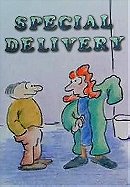
 18
18
 6.3
6.3
 0
0
